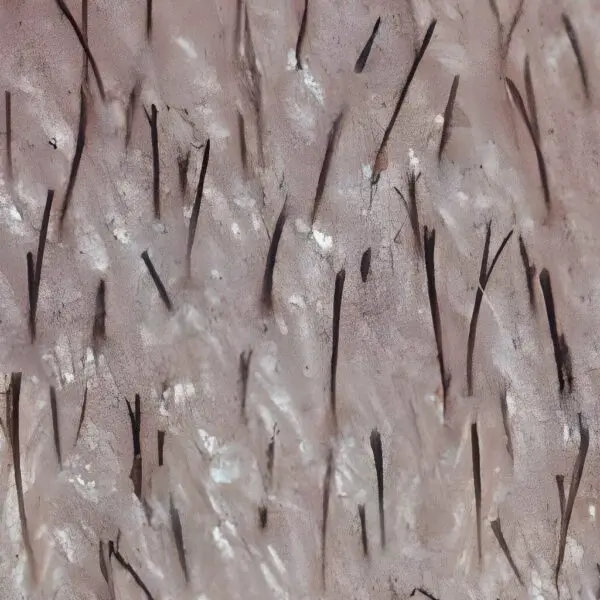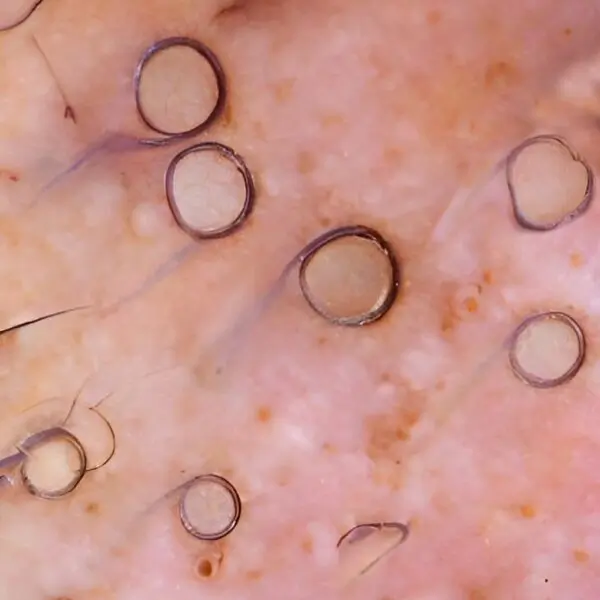Hair color is determined by a complex interplay of genetic, environmental, and physiological factors. Although genetics primarily dictate natural hair color, emerging evidence suggests that nutritional factors can impact hair pigmentation and the progression of hair color changes, including graying. This article explores the mechanisms by which key nutrients and dietary patterns may influence hair pigmentation, focusing on vitamins, minerals, and antioxidants.
Background: Hair color is primarily determined by the type, distribution, and concentration of melanin pigments produced in the hair follicles. Eumelanin, responsible for black and brown hues, and pheomelanin, which gives rise to red and yellow shades, are the two main types of melanin involved. While genetic factors are the major determinants of hair color, the influence of environmental and lifestyle factors, including nutrition, is gaining attention. Nutritional deficiencies or excesses can affect melanogenesis, the production of melanin, which in turn impacts hair pigmentation and may accelerate graying. This article examines the potential connections between dietary components and hair pigmentation changes, focusing on nutrients essential for melanin synthesis and antioxidant defense.
The Biochemical Basis of Hair Color and Melanin Synthesis: Melanogenesis is a process influenced by enzymes such as tyrosinase, tyrosine hydroxylase, and dopachrome tautomerase, which are involved in the biosynthesis of melanin from the amino acid tyrosine. The availability of these enzymes and the oxidative environment within the melanocytes of the hair follicle play important roles in hair pigmentation. Reactive oxygen species (ROS), if not adequately neutralized, can oxidize melanin or disrupt melanocyte function, leading to hair graying or color loss.
Role of Nutrition in Supporting Melanogenesis Certain nutrients are involved in the biochemical pathways of melanin production. For instance, copper and iron serve as cofactors for enzymes like tyrosinase, which is needed for the initial steps of melanin synthesis. Similarly, the amino acid tyrosine, derived from protein-rich foods, is a direct precursor to melanin. A lack of these nutrients may disrupt melanin production, potentially altering hair color.
Key Nutrients and Their Impact on Hair Color : Several nutrients can have an effect on hair color.
Copper: Copper is a crucial trace mineral that acts as a cofactor for tyrosinase, an enzyme central to melanin production. Studies have indicated that copper deficiency can reduce tyrosinase activity, limiting melanin synthesis and leading to hypopigmentation, which can contribute to premature graying. Dietary sources of copper include shellfish, nuts, seeds, and whole grains. Supplementing copper in deficient individuals has been shown to restore some pigment production, although this may vary depending on genetic predispositions and other health factors.Iron: Iron deficiency has been associated with both hair loss and changes in hair pigmentation. Iron is necessary for the transportation of oxygen, which supports cellular functions in melanocytes. Low iron levels can contribute to a loss of color, particularly in individuals already prone to iron-deficiency anemia. Foods rich in iron, such as red meat, lentils, and leafy green vegetables, are recommended for maintaining optimal iron levels. There is some evidence that iron repletion may reverse or slow hair color loss, although more research is needed to confirm this. Note however, that mega-dosing on iron supplements is dangerous. Our bodies can only process a certain level of iron per day. If we take in more than this level, the iron is toxic and will lead to severe illness and even death in extreme cases.Tyrosine and Phenylalanine: As precursors in the melanin biosynthesis pathway, tyrosine and phenylalanine are amino acids that can influence pigmentation. They are typically found in protein-rich foods like meat, dairy, eggs, and soy products. Diets deficient in these amino acids could theoretically hinder melanin production, though concrete evidence linking dietary tyrosine levels to hair color changes remains limited.Vitamin B Complex (especially B12, B6, and Biotin): The B vitamins, particularly B12, B6, and biotin, are implicated in various physiological processes that can indirectly influence hair pigmentation. Vitamin B12 deficiency has been linked to premature graying and hair loss. B vitamins support red blood cell formation and oxygen transportation, which are vital for hair follicle health. B12 deficiencies, in particular, can disrupt normal hair pigmentation and accelerate graying. This vitamin is primarily found in animal products, including meat, fish, dairy, and eggs.Zinc: Zinc deficiency can lead to hypopigmentation and structural abnormalities in hair. Zinc is involved in protein synthesis and cell division, both of which are critical in maintaining hair health and pigment production. Zinc can be found in foods such as meat, shellfish, legumes, and seeds, and adequate zinc levels are needed for preventing color changes in the hair.Antioxidants (Vitamin E, Vitamin C, and Polyphenols): Oxidative stress is a significant contributor to hair aging and graying. Melanocytes are vulnerable to reactive oxygen species ( ROS), and when antioxidant defenses are overwhelmed, melanocyte cell function may decline, leading to pigment loss. Antioxidants such as vitamins E and C, along with polyphenols from fruits, vegetables, and also teas, help neutralize ROS and protect the hair follicles from overall oxidative damage. High-antioxidant diets may theoretically delay graying by preserving melanocyte function longer.Vitamin D3: Vitamin D3, commonly referred to as the “sunshine vitamin,” plays a significant role in numerous physiological processes, including cellular health, immune function, and hair follicle cycling. Although Vitamin D3 is not directly involved in melanin synthesis, its broader role in hair follicle health may indirectly influence hair pigmentation. At least one study has identified a deficiency in vitamin D3 in people with premature gray hair development. Hair follicles contain vitamin D receptors (VDRs), which are necessary for proper hair growth and follicle cycling. Laboratory studies suggest that VDR activation by Vitamin D3 can stimulate melanogenesis and maintain melanocyte function. Reduced VDR expression or Vitamin D3 deficiency has been linked to impaired hair follicle activity, which may contribute to premature graying or hair loss. Dietary Patterns and Hair Color Maintenance: While individual nutrients are critical, dietary patterns as a whole may also impact hair pigmentation. Diets rich in whole foods, particularly those following Mediterranean or plant-based principles, tend to have higher levels of antioxidants and essential minerals. For instance, the high intake of fruits, vegetables, whole grains, and healthy fats associated with these diets can reduce oxidative stress, potentially delaying the onset of gray hair.
Conversely, diets high in processed foods, sugars, and trans fats have been linked to increased oxidative stress and inflammation, which may accelerate graying. Furthermore, excessive alcohol intake can deplete the body’s levels of essential nutrients like B vitamins and zinc, which are necessary for maintaining healthy pigmentation.
Clinical Evidence and Limitations: Most research linking nutrition and hair color is observational or based on animal studies, with a few clinical trials evaluating the efficacy of nutritional supplements on hair pigmentation. For instance, studies examining copper and iron supplementation show potential in individuals with known deficiencies but less significant effects in those with adequate levels. Notably, high levels of metals like iron and copper can be toxic at high doses and can have negative effects on hair growth and health in general. Additionally, since graying is often a genetically driven process, the impact of nutrition on hair color may be limited in individuals predisposed to early graying.
Future Directions and Potential for Nutritional Interventions: Emerging research into nutraceuticals, particularly antioxidant and mineral supplements, has opened new avenues for exploring their potential in delaying or reversing gray hair. Additionally, genetic studies may help identify populations more likely to benefit from targeted nutritional interventions. However, more robust, controlled clinical studies are needed to clarify the extent to which nutrition can influence hair pigmentation.
Conclusion: While genetics play a primary role in determining hair color, nutritional factors can influence hair pigmentation and the progression of graying to some extent. Essential minerals like copper and iron, alongside antioxidants and B vitamins, support proper melanocyte function and melanin production, while deficiencies may accelerate pigment loss. However, the effects of diet on hair color are nuanced, with individual variability playing a significant role. A balanced diet rich in whole foods, antioxidants, and essential nutrients is likely beneficial not only for overall health but may also support hair pigmentation longevity.
Bibliography
11711645 {11711645:UI3977CZ},{11711645:NJGP3XKS},{11711645:XFMC8DK5},{11711645:W76DPIK2},{11711645:K2P7RVX7},{11711645:4MRZBNXA},{11711645:KPXX8RC3},{11711645:5RBKMQ78},{11711645:97JP4NBR},{11711645:GSMVBVAX},{11711645:62V56FRM},{11711645:PKICKDRB},{11711645:KDUZSCIQ},{11711645:HQX2K7EC},{11711645:828TK2HP},{11711645:54XAMJHV},{11711645:PA5453ZT} 1 vancouver 50 date asc 1688 https://www.keratin.com/wp-content/plugins/zotpress/ %7B%22status%22%3A%22success%22%2C%22updateneeded%22%3Afalse%2C%22instance%22%3Afalse%2C%22meta%22%3A%7B%22request_last%22%3A0%2C%22request_next%22%3A0%2C%22used_cache%22%3Atrue%7D%2C%22data%22%3A%5B%7B%22key%22%3A%22KDUZSCIQ%22%2C%22library%22%3A%7B%22id%22%3A11711645%7D%2C%22meta%22%3A%7B%22creatorSummary%22%3A%22Frost%22%2C%22parsedDate%22%3A%221948-07%22%2C%22numChildren%22%3A0%7D%2C%22bib%22%3A%22%26lt%3Bdiv%20class%3D%26quot%3Bcsl-bib-body%26quot%3B%20style%3D%26quot%3Bline-height%3A%201.35%3B%20%26quot%3B%26gt%3B%5Cn%20%20%26lt%3Bdiv%20class%3D%26quot%3Bcsl-entry%26quot%3B%20style%3D%26quot%3Bclear%3A%20left%3B%20%26quot%3B%26gt%3B%5Cn%20%20%20%20%26lt%3Bdiv%20class%3D%26quot%3Bcsl-left-margin%26quot%3B%20style%3D%26quot%3Bfloat%3A%20left%3B%20padding-right%3A%200.5em%3B%20text-align%3A%20right%3B%20width%3A%201em%3B%26quot%3B%26gt%3B1.%26lt%3B%5C%2Fdiv%26gt%3B%26lt%3Bdiv%20class%3D%26quot%3Bcsl-right-inline%26quot%3B%20style%3D%26quot%3Bmargin%3A%200%20.4em%200%201.5em%3B%26quot%3B%26gt%3BFrost%20DV.%20The%20relation%20of%20nutritional%20deficiencies%20to%20graying.%20Physiol%20Rev.%201948%20July%3B28%283%29%3A368%26%23x2013%3B82.%26lt%3B%5C%2Fdiv%26gt%3B%5Cn%20%20%20%26lt%3B%5C%2Fdiv%26gt%3B%5Cn%26lt%3B%5C%2Fdiv%26gt%3B%22%2C%22data%22%3A%7B%22itemType%22%3A%22journalArticle%22%2C%22title%22%3A%22The%20relation%20of%20nutritional%20deficiencies%20to%20graying%22%2C%22creators%22%3A%5B%7B%22creatorType%22%3A%22author%22%2C%22firstName%22%3A%22D.%20V.%22%2C%22lastName%22%3A%22Frost%22%7D%5D%2C%22abstractNote%22%3A%22%22%2C%22date%22%3A%221948-07%22%2C%22language%22%3A%22eng%22%2C%22DOI%22%3A%2210.1152%5C%2Fphysrev.1948.28.3.368%22%2C%22ISSN%22%3A%220031-9333%22%2C%22url%22%3A%22%22%2C%22collections%22%3A%5B%22QC6F887X%22%5D%2C%22dateModified%22%3A%222024-11-03T15%3A48%3A11Z%22%7D%7D%2C%7B%22key%22%3A%22K2P7RVX7%22%2C%22library%22%3A%7B%22id%22%3A11711645%7D%2C%22meta%22%3A%7B%22creatorSummary%22%3A%22Sato%20et%20al.%22%2C%22parsedDate%22%3A%221989-04%22%2C%22numChildren%22%3A0%7D%2C%22bib%22%3A%22%26lt%3Bdiv%20class%3D%26quot%3Bcsl-bib-body%26quot%3B%20style%3D%26quot%3Bline-height%3A%201.35%3B%20%26quot%3B%26gt%3B%5Cn%20%20%26lt%3Bdiv%20class%3D%26quot%3Bcsl-entry%26quot%3B%20style%3D%26quot%3Bclear%3A%20left%3B%20%26quot%3B%26gt%3B%5Cn%20%20%20%20%26lt%3Bdiv%20class%3D%26quot%3Bcsl-left-margin%26quot%3B%20style%3D%26quot%3Bfloat%3A%20left%3B%20padding-right%3A%200.5em%3B%20text-align%3A%20right%3B%20width%3A%201em%3B%26quot%3B%26gt%3B1.%26lt%3B%5C%2Fdiv%26gt%3B%26lt%3Bdiv%20class%3D%26quot%3Bcsl-right-inline%26quot%3B%20style%3D%26quot%3Bmargin%3A%200%20.4em%200%201.5em%3B%26quot%3B%26gt%3BSato%20S%2C%20Jitsukawa%20K%2C%20Sato%20H%2C%20Yoshino%20M%2C%20Seta%20S%2C%20Ito%20S%2C%20et%20al.%20Segmented%20heterochromia%20in%20black%20scalp%20hair%20associated%20with%20iron-deficiency%20anemia.%20Canities%20segmentata%20sideropaenica.%20Arch%20Dermatol.%201989%20Apr%3B125%284%29%3A531%26%23x2013%3B5.%26lt%3B%5C%2Fdiv%26gt%3B%5Cn%20%20%20%26lt%3B%5C%2Fdiv%26gt%3B%5Cn%26lt%3B%5C%2Fdiv%26gt%3B%22%2C%22data%22%3A%7B%22itemType%22%3A%22journalArticle%22%2C%22title%22%3A%22Segmented%20heterochromia%20in%20black%20scalp%20hair%20associated%20with%20iron-deficiency%20anemia.%20Canities%20segmentata%20sideropaenica%22%2C%22creators%22%3A%5B%7B%22creatorType%22%3A%22author%22%2C%22firstName%22%3A%22S.%22%2C%22lastName%22%3A%22Sato%22%7D%2C%7B%22creatorType%22%3A%22author%22%2C%22firstName%22%3A%22K.%22%2C%22lastName%22%3A%22Jitsukawa%22%7D%2C%7B%22creatorType%22%3A%22author%22%2C%22firstName%22%3A%22H.%22%2C%22lastName%22%3A%22Sato%22%7D%2C%7B%22creatorType%22%3A%22author%22%2C%22firstName%22%3A%22M.%22%2C%22lastName%22%3A%22Yoshino%22%7D%2C%7B%22creatorType%22%3A%22author%22%2C%22firstName%22%3A%22S.%22%2C%22lastName%22%3A%22Seta%22%7D%2C%7B%22creatorType%22%3A%22author%22%2C%22firstName%22%3A%22S.%22%2C%22lastName%22%3A%22Ito%22%7D%2C%7B%22creatorType%22%3A%22author%22%2C%22firstName%22%3A%22Y.%22%2C%22lastName%22%3A%22Hayashi%22%7D%2C%7B%22creatorType%22%3A%22author%22%2C%22firstName%22%3A%22T.%22%2C%22lastName%22%3A%22Anzai%22%7D%5D%2C%22abstractNote%22%3A%22A%20newly%20recognized%20disorder%20of%20black%20scalp%20hair%20is%20characterized%20by%20the%20irregularly%20alternating%20segmentation%20of%20hair%20into%20dark%20and%20light%20bands.%20A%2015-year-old%20girl%20had%20segmented%20heterochromic%20scalp%20hair%20in%20association%20with%20iron-deficiency%20anemia.%20The%20clinical%20and%20laboratory%20investigations%20support%20the%20view%20that%20low%20serum%20iron%20levels%20play%20a%20critical%20role%20in%20reducing%20eumelanogenesis%20and%20in%20the%20possible%20failure%20of%20melanin%20transfer.%20The%20segmented%20heterochromic%20hair%20recovered%20completely%20after%20iron%20supplementation%2C%20which%20coincided%20with%20increased%20eumelanogenesis%20in%20the%20recovered%20hair.%20This%20clinical%20experience%20indicated%20participation%20of%20iron%20in%20the%20kinetics%20of%20melanogenesis%20within%20the%20follicular%20melanocytes.%22%2C%22date%22%3A%221989-04%22%2C%22language%22%3A%22eng%22%2C%22DOI%22%3A%22%22%2C%22ISSN%22%3A%220003-987X%22%2C%22url%22%3A%22%22%2C%22collections%22%3A%5B%22QC6F887X%22%5D%2C%22dateModified%22%3A%222024-11-03T16%3A13%3A43Z%22%7D%7D%2C%7B%22key%22%3A%224MRZBNXA%22%2C%22library%22%3A%7B%22id%22%3A11711645%7D%2C%22meta%22%3A%7B%22creatorSummary%22%3A%22Arck%20et%20al.%22%2C%22parsedDate%22%3A%222006-07%22%2C%22numChildren%22%3A0%7D%2C%22bib%22%3A%22%26lt%3Bdiv%20class%3D%26quot%3Bcsl-bib-body%26quot%3B%20style%3D%26quot%3Bline-height%3A%201.35%3B%20%26quot%3B%26gt%3B%5Cn%20%20%26lt%3Bdiv%20class%3D%26quot%3Bcsl-entry%26quot%3B%20style%3D%26quot%3Bclear%3A%20left%3B%20%26quot%3B%26gt%3B%5Cn%20%20%20%20%26lt%3Bdiv%20class%3D%26quot%3Bcsl-left-margin%26quot%3B%20style%3D%26quot%3Bfloat%3A%20left%3B%20padding-right%3A%200.5em%3B%20text-align%3A%20right%3B%20width%3A%201em%3B%26quot%3B%26gt%3B1.%26lt%3B%5C%2Fdiv%26gt%3B%26lt%3Bdiv%20class%3D%26quot%3Bcsl-right-inline%26quot%3B%20style%3D%26quot%3Bmargin%3A%200%20.4em%200%201.5em%3B%26quot%3B%26gt%3BArck%20PC%2C%20Overall%20R%2C%20Spatz%20K%2C%20Liezman%20C%2C%20Handjiski%20B%2C%20Klapp%20BF%2C%20et%20al.%20Towards%20a%20%26%23x201C%3Bfree%20radical%20theory%20of%20graying%26%23x201D%3B%3A%20melanocyte%20apoptosis%20in%20the%20aging%20human%20hair%20follicle%20is%20an%20indicator%20of%20oxidative%20stress%20induced%20tissue%20damage.%20FASEB%20J.%202006%20July%3B20%289%29%3A1567%26%23x2013%3B9.%26lt%3B%5C%2Fdiv%26gt%3B%5Cn%20%20%20%26lt%3B%5C%2Fdiv%26gt%3B%5Cn%26lt%3B%5C%2Fdiv%26gt%3B%22%2C%22data%22%3A%7B%22itemType%22%3A%22journalArticle%22%2C%22title%22%3A%22Towards%20a%20%5C%22free%20radical%20theory%20of%20graying%5C%22%3A%20melanocyte%20apoptosis%20in%20the%20aging%20human%20hair%20follicle%20is%20an%20indicator%20of%20oxidative%20stress%20induced%20tissue%20damage%22%2C%22creators%22%3A%5B%7B%22creatorType%22%3A%22author%22%2C%22firstName%22%3A%22Petra%20Clara%22%2C%22lastName%22%3A%22Arck%22%7D%2C%7B%22creatorType%22%3A%22author%22%2C%22firstName%22%3A%22Rupert%22%2C%22lastName%22%3A%22Overall%22%7D%2C%7B%22creatorType%22%3A%22author%22%2C%22firstName%22%3A%22Katharina%22%2C%22lastName%22%3A%22Spatz%22%7D%2C%7B%22creatorType%22%3A%22author%22%2C%22firstName%22%3A%22Christiane%22%2C%22lastName%22%3A%22Liezman%22%7D%2C%7B%22creatorType%22%3A%22author%22%2C%22firstName%22%3A%22Bori%22%2C%22lastName%22%3A%22Handjiski%22%7D%2C%7B%22creatorType%22%3A%22author%22%2C%22firstName%22%3A%22Burghard%20F.%22%2C%22lastName%22%3A%22Klapp%22%7D%2C%7B%22creatorType%22%3A%22author%22%2C%22firstName%22%3A%22Mark%20A.%22%2C%22lastName%22%3A%22Birch-Machin%22%7D%2C%7B%22creatorType%22%3A%22author%22%2C%22firstName%22%3A%22Eva%20Milena%20Johanne%22%2C%22lastName%22%3A%22Peters%22%7D%5D%2C%22abstractNote%22%3A%22Oxidative%20stress%20is%20generated%20by%20a%20multitude%20of%20environmental%20and%20endogenous%20challenges%20such%20as%20radiation%2C%20inflammation%2C%20or%20psychoemotional%20stress.%20It%20also%20speeds%20the%20aging%20process.%20Graying%20is%20a%20prominent%20but%20little%20understood%20feature%20of%20aging.%20Intriguingly%2C%20the%20continuous%20melanin%20synthesis%20in%20the%20growing%20%28anagen%29%20hair%20follicle%20generates%20high%20oxidative%20stress.%20We%20therefore%20hypothesize%20that%20hair%20bulb%20melanocytes%20are%20especially%20susceptible%20to%20free%20radical-induced%20aging.%20To%20test%20this%20hypothesis%2C%20we%20subjected%20human%20scalp%20skin%20anagen%20hair%20follicles%20from%20graying%20individuals%20to%20macroscopic%20and%20immunohistomorphometric%20analysis%20and%20organ%20culture.%20We%20found%20evidence%20of%20melanocyte%20apoptosis%20and%20increased%20oxidative%20stress%20in%20the%20pigmentary%20unit%20of%20graying%20hair%20follicles.%20The%20%26quot%3Bcommon%26quot%3B%20deletion%2C%20a%20marker%20mitochondrial%20DNA-deletion%20for%20accumulating%20oxidative%20stress%20damage%2C%20occurred%20most%20prominently%20in%20graying%20hair%20follicles.%20Cultured%20unpigmented%20hair%20follicles%20grew%20better%20than%20pigmented%20follicles%20of%20the%20same%20donors.%20Finally%2C%20cultured%20pigmented%20hair%20follicles%20exposed%20to%20exogenous%20oxidative%20stress%20%28hydroquinone%29%20showed%20increased%20melanocyte%20apoptosis%20in%20the%20hair%20bulb.%20We%20conclude%20that%20oxidative%20stress%20is%20high%20in%20hair%20follicle%20melanocytes%20and%20leads%20to%20their%20selective%20premature%20aging%20and%20apoptosis.%20The%20graying%20hair%20follicle%2C%20therefore%2C%20offers%20a%20unique%20model%20system%20to%20study%20oxidative%20stress%20and%20aging%20and%20to%20test%20antiaging%20therapeutics%20in%20their%20ability%20to%20slow%20down%20or%20even%20stop%20this%20process.%22%2C%22date%22%3A%222006-07%22%2C%22language%22%3A%22eng%22%2C%22DOI%22%3A%2210.1096%5C%2Ffj.05-4039fje%22%2C%22ISSN%22%3A%221530-6860%22%2C%22url%22%3A%22%22%2C%22collections%22%3A%5B%22QC6F887X%22%5D%2C%22dateModified%22%3A%222024-11-03T16%3A12%3A52Z%22%7D%7D%2C%7B%22key%22%3A%22PA5453ZT%22%2C%22library%22%3A%7B%22id%22%3A11711645%7D%2C%22meta%22%3A%7B%22creatorSummary%22%3A%22Tr%5Cu00fceb%22%2C%22parsedDate%22%3A%222009-01%22%2C%22numChildren%22%3A0%7D%2C%22bib%22%3A%22%26lt%3Bdiv%20class%3D%26quot%3Bcsl-bib-body%26quot%3B%20style%3D%26quot%3Bline-height%3A%201.35%3B%20%26quot%3B%26gt%3B%5Cn%20%20%26lt%3Bdiv%20class%3D%26quot%3Bcsl-entry%26quot%3B%20style%3D%26quot%3Bclear%3A%20left%3B%20%26quot%3B%26gt%3B%5Cn%20%20%20%20%26lt%3Bdiv%20class%3D%26quot%3Bcsl-left-margin%26quot%3B%20style%3D%26quot%3Bfloat%3A%20left%3B%20padding-right%3A%200.5em%3B%20text-align%3A%20right%3B%20width%3A%201em%3B%26quot%3B%26gt%3B1.%26lt%3B%5C%2Fdiv%26gt%3B%26lt%3Bdiv%20class%3D%26quot%3Bcsl-right-inline%26quot%3B%20style%3D%26quot%3Bmargin%3A%200%20.4em%200%201.5em%3B%26quot%3B%26gt%3BTr%26%23xFC%3Beb%20RM.%20Oxidative%20stress%20in%20ageing%20of%20hair.%20Int%20J%20Trichology.%202009%20Jan%3B1%281%29%3A6%26%23x2013%3B14.%26lt%3B%5C%2Fdiv%26gt%3B%5Cn%20%20%20%26lt%3B%5C%2Fdiv%26gt%3B%5Cn%26lt%3B%5C%2Fdiv%26gt%3B%22%2C%22data%22%3A%7B%22itemType%22%3A%22journalArticle%22%2C%22title%22%3A%22Oxidative%20stress%20in%20ageing%20of%20hair%22%2C%22creators%22%3A%5B%7B%22creatorType%22%3A%22author%22%2C%22firstName%22%3A%22Ralph%20M.%22%2C%22lastName%22%3A%22Tr%5Cu00fceb%22%7D%5D%2C%22abstractNote%22%3A%22Experimental%20evidence%20supports%20the%20hypothesis%20that%20oxidative%20stress%20plays%20a%20major%20role%20in%20the%20ageing%20process.%20Reactive%20oxygen%20species%20are%20generated%20by%20a%20multitude%20of%20endogenous%20and%20environmental%20challenges.%20Reactive%20oxygen%20species%20or%20free%20radicals%20are%20highly%20reactive%20molecules%20that%20can%20directly%20damage%20cellular%20structural%20membranes%2C%20lipids%2C%20proteins%2C%20and%20DNA.%20The%20body%20possesses%20endogenous%20defence%20mechanisms%2C%20such%20as%20antioxidative%20enzymes%20and%20non-enzymatic%20antioxidative%20molecules%2C%20protecting%20it%20from%20free%20radicals%20by%20reducing%20and%20neutralizing%20them.%20With%20age%2C%20the%20production%20of%20free%20radicals%20increases%2C%20while%20the%20endogenous%20defence%20mechanisms%20decrease.%20This%20imbalance%20leads%20to%20the%20progressive%20damage%20of%20cellular%20structures%2C%20presumably%20resulting%20in%20the%20ageing%20phenotype.%20Ageing%20of%20hair%20manifests%20as%20decrease%20of%20melanocyte%20function%20or%20graying%2C%20and%20decrease%20in%20hair%20production%20or%20alopecia.%20There%20is%20circumstantial%20evidence%20that%20oxidative%20stress%20may%20be%20a%20pivotal%20mechanism%20contributing%20to%20hair%20graying%20and%20hair%20loss.%20New%20insights%20into%20the%20role%20and%20prevention%20of%20oxidative%20stress%20could%20open%20new%20strategies%20for%20intervention%20and%20reversal%20of%20the%20hair%20graying%20process%20and%20age-dependent%20alopecia.%22%2C%22date%22%3A%222009-01%22%2C%22language%22%3A%22eng%22%2C%22DOI%22%3A%2210.4103%5C%2F0974-7753.51923%22%2C%22ISSN%22%3A%220974-9241%22%2C%22url%22%3A%22%22%2C%22collections%22%3A%5B%22QC6F887X%22%5D%2C%22dateModified%22%3A%222024-11-03T15%3A41%3A03Z%22%7D%7D%2C%7B%22key%22%3A%22HQX2K7EC%22%2C%22library%22%3A%7B%22id%22%3A11711645%7D%2C%22meta%22%3A%7B%22creatorSummary%22%3A%22Yu%20et%20al.%22%2C%22parsedDate%22%3A%222012%22%2C%22numChildren%22%3A0%7D%2C%22bib%22%3A%22%26lt%3Bdiv%20class%3D%26quot%3Bcsl-bib-body%26quot%3B%20style%3D%26quot%3Bline-height%3A%201.35%3B%20%26quot%3B%26gt%3B%5Cn%20%20%26lt%3Bdiv%20class%3D%26quot%3Bcsl-entry%26quot%3B%20style%3D%26quot%3Bclear%3A%20left%3B%20%26quot%3B%26gt%3B%5Cn%20%20%20%20%26lt%3Bdiv%20class%3D%26quot%3Bcsl-left-margin%26quot%3B%20style%3D%26quot%3Bfloat%3A%20left%3B%20padding-right%3A%200.5em%3B%20text-align%3A%20right%3B%20width%3A%201em%3B%26quot%3B%26gt%3B1.%26lt%3B%5C%2Fdiv%26gt%3B%26lt%3Bdiv%20class%3D%26quot%3Bcsl-right-inline%26quot%3B%20style%3D%26quot%3Bmargin%3A%200%20.4em%200%201.5em%3B%26quot%3B%26gt%3BYu%20M%2C%20Bell%20RH%2C%20Ho%20MM%2C%20Leung%20G%2C%20Haegert%20A%2C%20Carr%20N%2C%20et%20al.%20Deficiency%20in%20nucleotide%20excision%20repair%20family%20gene%20activity%2C%20especially%20ERCC3%2C%20is%20associated%20with%20non-pigmented%20hair%20fiber%20growth.%20PLoS%20One.%202012%3B7%285%29%3Ae34185.%26lt%3B%5C%2Fdiv%26gt%3B%5Cn%20%20%20%26lt%3B%5C%2Fdiv%26gt%3B%5Cn%26lt%3B%5C%2Fdiv%26gt%3B%22%2C%22data%22%3A%7B%22itemType%22%3A%22journalArticle%22%2C%22title%22%3A%22Deficiency%20in%20nucleotide%20excision%20repair%20family%20gene%20activity%2C%20especially%20ERCC3%2C%20is%20associated%20with%20non-pigmented%20hair%20fiber%20growth%22%2C%22creators%22%3A%5B%7B%22creatorType%22%3A%22author%22%2C%22firstName%22%3A%22Mei%22%2C%22lastName%22%3A%22Yu%22%7D%2C%7B%22creatorType%22%3A%22author%22%2C%22firstName%22%3A%22Robert%20H.%22%2C%22lastName%22%3A%22Bell%22%7D%2C%7B%22creatorType%22%3A%22author%22%2C%22firstName%22%3A%22Maggie%20M.%22%2C%22lastName%22%3A%22Ho%22%7D%2C%7B%22creatorType%22%3A%22author%22%2C%22firstName%22%3A%22Gigi%22%2C%22lastName%22%3A%22Leung%22%7D%2C%7B%22creatorType%22%3A%22author%22%2C%22firstName%22%3A%22Anne%22%2C%22lastName%22%3A%22Haegert%22%7D%2C%7B%22creatorType%22%3A%22author%22%2C%22firstName%22%3A%22Nicholas%22%2C%22lastName%22%3A%22Carr%22%7D%2C%7B%22creatorType%22%3A%22author%22%2C%22firstName%22%3A%22Jerry%22%2C%22lastName%22%3A%22Shapiro%22%7D%2C%7B%22creatorType%22%3A%22author%22%2C%22firstName%22%3A%22Kevin%20J.%22%2C%22lastName%22%3A%22McElwee%22%7D%5D%2C%22abstractNote%22%3A%22We%20conducted%20a%20microarray%20study%20to%20discover%20gene%20expression%20patterns%20associated%20with%20a%20lack%20of%20melanogenesis%20in%20non-pigmented%20hair%20follicles%20%28HF%29%20by%20microarray.%20Pigmented%20and%20non-pigmented%20HFs%20were%20collected%20and%20micro-dissected%20into%20the%20hair%20bulb%20%28HB%29%20and%20the%20upper%20hair%20sheaths%20%28HS%29%20including%20the%20bulge%20region.%20In%20comparison%20to%20pigmented%20HS%20and%20HBs%2C%20nucleotide%20excision%20repair%20%28NER%29%20family%20genes%20ERCC1%2C%20ERCC2%2C%20ERCC3%2C%20ERCC4%2C%20ERCC5%2C%20ERCC6%2C%20XPA%2C%20NTPBP%2C%20HCNP%2C%20DDB2%20and%20POLH%20exhibited%20statistically%20significantly%20lower%20expression%20in%20non-%20pigmented%20HS%20and%20HBs.%20Quantitative%20PCR%20verified%20microarray%20data%20and%20identified%20ERCC3%20as%20highly%20differentially%20expressed.%20Immunohistochemistry%20confirmed%20ERCC3%20expression%20in%20HF%20melanocytes.%20A%20reduction%20in%20ERCC3%20by%20siRNA%20interference%20in%20human%20melanocytes%20in%20vitro%20reduced%20their%20tyrosinase%20production%20ability.%20Our%20results%20suggest%20that%20loss%20of%20NER%20gene%20function%20is%20associated%20with%20a%20loss%20of%20melanin%20production%20capacity.%20This%20may%20be%20due%20to%20reduced%20gene%20transcription%20and%5C%2For%20reduced%20DNA%20repair%20in%20melanocytes%20which%20may%20eventually%20lead%20to%20cell%20death.%20These%20results%20provide%20novel%20information%20with%20regard%20to%20melanogenesis%20and%20its%20regulation.%22%2C%22date%22%3A%222012%22%2C%22language%22%3A%22eng%22%2C%22DOI%22%3A%2210.1371%5C%2Fjournal.pone.0034185%22%2C%22ISSN%22%3A%221932-6203%22%2C%22url%22%3A%22%22%2C%22collections%22%3A%5B%22QC6F887X%22%5D%2C%22dateModified%22%3A%222024-11-03T15%3A42%3A23Z%22%7D%7D%2C%7B%22key%22%3A%22W76DPIK2%22%2C%22library%22%3A%7B%22id%22%3A11711645%7D%2C%22meta%22%3A%7B%22creatorSummary%22%3A%22Fatemi%20Naieni%20et%20al.%22%2C%22parsedDate%22%3A%222012-04%22%2C%22numChildren%22%3A0%7D%2C%22bib%22%3A%22%26lt%3Bdiv%20class%3D%26quot%3Bcsl-bib-body%26quot%3B%20style%3D%26quot%3Bline-height%3A%201.35%3B%20%26quot%3B%26gt%3B%5Cn%20%20%26lt%3Bdiv%20class%3D%26quot%3Bcsl-entry%26quot%3B%20style%3D%26quot%3Bclear%3A%20left%3B%20%26quot%3B%26gt%3B%5Cn%20%20%20%20%26lt%3Bdiv%20class%3D%26quot%3Bcsl-left-margin%26quot%3B%20style%3D%26quot%3Bfloat%3A%20left%3B%20padding-right%3A%200.5em%3B%20text-align%3A%20right%3B%20width%3A%201em%3B%26quot%3B%26gt%3B1.%26lt%3B%5C%2Fdiv%26gt%3B%26lt%3Bdiv%20class%3D%26quot%3Bcsl-right-inline%26quot%3B%20style%3D%26quot%3Bmargin%3A%200%20.4em%200%201.5em%3B%26quot%3B%26gt%3BFatemi%20Naieni%20F%2C%20Ebrahimi%20B%2C%20Vakilian%20HR%2C%20Shahmoradi%20Z.%20Serum%20iron%2C%20zinc%2C%20and%20copper%20concentration%20in%20premature%20graying%20of%20hair.%20Biol%20Trace%20Elem%20Res.%202012%20Apr%3B146%281%29%3A30%26%23x2013%3B4.%26lt%3B%5C%2Fdiv%26gt%3B%5Cn%20%20%20%26lt%3B%5C%2Fdiv%26gt%3B%5Cn%26lt%3B%5C%2Fdiv%26gt%3B%22%2C%22data%22%3A%7B%22itemType%22%3A%22journalArticle%22%2C%22title%22%3A%22Serum%20iron%2C%20zinc%2C%20and%20copper%20concentration%20in%20premature%20graying%20of%20hair%22%2C%22creators%22%3A%5B%7B%22creatorType%22%3A%22author%22%2C%22firstName%22%3A%22Farahnaz%22%2C%22lastName%22%3A%22Fatemi%20Naieni%22%7D%2C%7B%22creatorType%22%3A%22author%22%2C%22firstName%22%3A%22Bahareh%22%2C%22lastName%22%3A%22Ebrahimi%22%7D%2C%7B%22creatorType%22%3A%22author%22%2C%22firstName%22%3A%22Hamid%20Reza%22%2C%22lastName%22%3A%22Vakilian%22%7D%2C%7B%22creatorType%22%3A%22author%22%2C%22firstName%22%3A%22Zabihollah%22%2C%22lastName%22%3A%22Shahmoradi%22%7D%5D%2C%22abstractNote%22%3A%22Premature%20graying%20of%20hair%20with%20unclear%20etiology%2C%20which%20is%20known%20as%20premature%20canities%2C%20is%20a%20common%20cause%20of%20referrals%20to%20the%20dermatologists.%20We%20assessed%20the%20relationship%20between%20serum%20iron%2C%20copper%2C%20and%20zinc%20concentrations%20with%20premature%20canities.%20This%20study%20was%20conducted%20on%20patients%20under%2020%5Cu00a0years%20old%20suffering%20from%20premature%20canities%2C%20having%20a%20minimum%20of%20ten%20gray%20hair%20fibers%2C%20and%20referring%20to%20university%20hospitals%20of%20Isfahan%20%28Iran%29.%20The%20results%20were%20compared%20with%20age-sex-matched%20controls.%20Demographic%20data%20and%20disease%20characteristics%20were%20recorded%20for%20two%20groups.%20We%20studied%20serum%20iron%2C%20copper%2C%20and%20zinc%20concentrations%20of%2066%20patients%20and%2066%20controls%20using%20atomic%20absorption%20and%20Ferrozine%20methods.%20The%20mean%20age%20of%20studied%20cases%20was%2017.8%5Cu2009%5Cu00b1%5Cu20092.0%5Cu00a0years%2C%20and%20the%20mean%20age%20of%20the%20onset%20of%20canities%20was%2015.5%5Cu2009%5Cu00b1%5Cu20093.2%5Cu00a0years%20with%20no%20significant%20difference%20between%20males%20and%20females%20%28P%5Cu2009%26gt%3B%5Cu20090.05%29.%20Serum%20copper%20concentration%20was%20significantly%20lower%20in%20patients%20compared%20with%20controls%20%2890.7%5Cu2009%5Cu00b1%5Cu200937.4%20vs.%20105.3%5Cu2009%5Cu00b1%5Cu200950.2%5Cu00a0%5Cu03bcg%5C%2FdL%2C%20P%5Cu2009%3D%5Cu20090.048%29%2C%20but%20serum%20iron%20concentration%20was%20significantly%20lower%20in%20controls%20compared%20to%20patients%20%2888.8%5Cu2009%5Cu00b1%5Cu200939.5%20vs.%20108.3%5Cu2009%5Cu00b1%5Cu200948.4%5Cu00a0%5Cu03bcg%5C%2FdL%2C%20P%5Cu2009%3D%5Cu20090.008%29.%20Also%2C%20there%20was%20no%20significant%20difference%20between%20patients%20and%20controls%20in%20serum%20zinc%20concentration%20%28114.8%5Cu2009%5Cu00b1%5Cu200967.8%20vs.%20108.2%5Cu2009%5Cu00b1%5Cu200949.9%5Cu00a0%5Cu03bcg%5C%2FdL%2C%20P%5Cu2009%3D%5Cu20090.285%29.%20According%20to%20these%20results%2C%20among%20copper%2C%20zinc%2C%20and%20iron%2C%20a%20low%20serum%20copper%20concentration%20may%20play%20a%20role%20in%20premature%20graying%20of%20hairs%20in%20our%20society.%20Further%20studies%20are%20needed%20to%20find%20the%20underlying%20mechanism%20of%20this%20relationship.%22%2C%22date%22%3A%222012-04%22%2C%22language%22%3A%22eng%22%2C%22DOI%22%3A%2210.1007%5C%2Fs12011-011-9223-6%22%2C%22ISSN%22%3A%221559-0720%22%2C%22url%22%3A%22%22%2C%22collections%22%3A%5B%22QC6F887X%22%5D%2C%22dateModified%22%3A%222024-11-03T16%3A14%3A28Z%22%7D%7D%2C%7B%22key%22%3A%22KPXX8RC3%22%2C%22library%22%3A%7B%22id%22%3A11711645%7D%2C%22meta%22%3A%7B%22creatorSummary%22%3A%22Panhard%20et%20al.%22%2C%22parsedDate%22%3A%222012-10%22%2C%22numChildren%22%3A0%7D%2C%22bib%22%3A%22%26lt%3Bdiv%20class%3D%26quot%3Bcsl-bib-body%26quot%3B%20style%3D%26quot%3Bline-height%3A%201.35%3B%20%26quot%3B%26gt%3B%5Cn%20%20%26lt%3Bdiv%20class%3D%26quot%3Bcsl-entry%26quot%3B%20style%3D%26quot%3Bclear%3A%20left%3B%20%26quot%3B%26gt%3B%5Cn%20%20%20%20%26lt%3Bdiv%20class%3D%26quot%3Bcsl-left-margin%26quot%3B%20style%3D%26quot%3Bfloat%3A%20left%3B%20padding-right%3A%200.5em%3B%20text-align%3A%20right%3B%20width%3A%201em%3B%26quot%3B%26gt%3B1.%26lt%3B%5C%2Fdiv%26gt%3B%26lt%3Bdiv%20class%3D%26quot%3Bcsl-right-inline%26quot%3B%20style%3D%26quot%3Bmargin%3A%200%20.4em%200%201.5em%3B%26quot%3B%26gt%3BPanhard%20S%2C%20Lozano%20I%2C%20Loussouarn%20G.%20Greying%20of%20the%20human%20hair%3A%20a%20worldwide%20survey%2C%20revisiting%20the%20%26%23x201C%3B50%26%23x201D%3B%20rule%20of%20thumb.%20Br%20J%20Dermatol.%202012%20Oct%3B167%284%29%3A865%26%23x2013%3B73.%26lt%3B%5C%2Fdiv%26gt%3B%5Cn%20%20%20%26lt%3B%5C%2Fdiv%26gt%3B%5Cn%26lt%3B%5C%2Fdiv%26gt%3B%22%2C%22data%22%3A%7B%22itemType%22%3A%22journalArticle%22%2C%22title%22%3A%22Greying%20of%20the%20human%20hair%3A%20a%20worldwide%20survey%2C%20revisiting%20the%20%2750%27%20rule%20of%20thumb%22%2C%22creators%22%3A%5B%7B%22creatorType%22%3A%22author%22%2C%22firstName%22%3A%22S.%22%2C%22lastName%22%3A%22Panhard%22%7D%2C%7B%22creatorType%22%3A%22author%22%2C%22firstName%22%3A%22I.%22%2C%22lastName%22%3A%22Lozano%22%7D%2C%7B%22creatorType%22%3A%22author%22%2C%22firstName%22%3A%22G.%22%2C%22lastName%22%3A%22Loussouarn%22%7D%5D%2C%22abstractNote%22%3A%22BACKGROUND%3A%20While%20numerous%20papers%20have%20reported%20on%20the%20biological%20mechanisms%20of%20human%20hair%20pigmentation%20and%20greying%2C%20epidemiological%20descriptions%20of%20both%20natural%20hair%20colour%20and%20the%20greying%20process%2C%20worldwide%2C%20remain%20scarce.%5CnOBJECTIVES%3A%20To%20assess%20hair%20colour%20and%20greying%20in%20a%20large%20world%20sample%20of%20human%20subjects%2C%20and%20to%20revisit%20the%20validity%20of%20the%2050%5C%2F50%5C%2F50%20rule%20of%20thumb%2C%20which%20states%20that%20%26%23039%3Bat%20age%2050%20years%2C%2050%25%20of%20the%20population%20has%20at%20least%2050%25%20grey%20hair%26%23039%3B.%5CnMETHODS%3A%20The%20natural%20hair%20colour%20of%204192%20healthy%20male%20and%20female%20volunteers%20was%20assessed%20using%20a%20sensorial%20expert%20evaluation%20through%20the%20comparison%20of%20each%20volunteer%26%23039%3Bs%20hair%20with%20standard%20swatches.%20Hair%20colour%20was%20studied%20according%20to%20age%2C%20gender%20and%20ethnic%20or%20geographical%20origin.%5CnRESULTS%3A%20Overall%20we%20observed%20that%20between%2045%20and%2065%20years%20of%20age%2C%2074%25%20of%20people%20were%20affected%20by%20grey%20hair%20with%20a%20mean%20intensity%20of%2027%25.%20Men%20harboured%20significantly%20more%20grey%20hair%20than%20women.%20Both%20age%20at%20onset%20and%20rate%20of%20greying%20with%20age%20appeared%20to%20be%20clearly%20linked%20to%20ethnic%5C%2Fgeographical%20origin.%20Subjects%20of%20Asian%20and%20African%20descent%20showed%20less%20grey%20hair%20than%20those%20of%20caucasian%20origin%2C%20at%20comparable%20ages%2C%20confirming%20previously%20reported%20data.%5CnCONCLUSIONS%3A%20Calculating%20the%20percentage%20of%20people%20showing%20at%20least%2050%25%20grey%20hair%20coverage%20at%20age%2050%20years%20leads%20to%20a%20global%20range%20of%206-23%25%2C%20according%20to%20ethnic%5C%2Fgeographical%20origin%20and%20natural%20hair%20colour%3A%20well%20below%20that%20expressed%20by%20the%20%26%23039%3B50%26%23039%3B%20rule%20of%20thumb.%22%2C%22date%22%3A%222012-10%22%2C%22language%22%3A%22eng%22%2C%22DOI%22%3A%2210.1111%5C%2Fj.1365-2133.2012.11095.x%22%2C%22ISSN%22%3A%221365-2133%22%2C%22url%22%3A%22%22%2C%22collections%22%3A%5B%22QC6F887X%22%5D%2C%22dateModified%22%3A%222024-11-03T16%3A11%3A30Z%22%7D%7D%2C%7B%22key%22%3A%22PKICKDRB%22%2C%22library%22%3A%7B%22id%22%3A11711645%7D%2C%22meta%22%3A%7B%22creatorSummary%22%3A%22Finner%22%2C%22parsedDate%22%3A%222013-01%22%2C%22numChildren%22%3A0%7D%2C%22bib%22%3A%22%26lt%3Bdiv%20class%3D%26quot%3Bcsl-bib-body%26quot%3B%20style%3D%26quot%3Bline-height%3A%201.35%3B%20%26quot%3B%26gt%3B%5Cn%20%20%26lt%3Bdiv%20class%3D%26quot%3Bcsl-entry%26quot%3B%20style%3D%26quot%3Bclear%3A%20left%3B%20%26quot%3B%26gt%3B%5Cn%20%20%20%20%26lt%3Bdiv%20class%3D%26quot%3Bcsl-left-margin%26quot%3B%20style%3D%26quot%3Bfloat%3A%20left%3B%20padding-right%3A%200.5em%3B%20text-align%3A%20right%3B%20width%3A%201em%3B%26quot%3B%26gt%3B1.%26lt%3B%5C%2Fdiv%26gt%3B%26lt%3Bdiv%20class%3D%26quot%3Bcsl-right-inline%26quot%3B%20style%3D%26quot%3Bmargin%3A%200%20.4em%200%201.5em%3B%26quot%3B%26gt%3BFinner%20AM.%20Nutrition%20and%20hair%3A%20deficiencies%20and%20supplements.%20Dermatol%20Clin.%202013%20Jan%3B31%281%29%3A167%26%23x2013%3B72.%26lt%3B%5C%2Fdiv%26gt%3B%5Cn%20%20%20%26lt%3B%5C%2Fdiv%26gt%3B%5Cn%26lt%3B%5C%2Fdiv%26gt%3B%22%2C%22data%22%3A%7B%22itemType%22%3A%22journalArticle%22%2C%22title%22%3A%22Nutrition%20and%20hair%3A%20deficiencies%20and%20supplements%22%2C%22creators%22%3A%5B%7B%22creatorType%22%3A%22author%22%2C%22firstName%22%3A%22Andreas%20M.%22%2C%22lastName%22%3A%22Finner%22%7D%5D%2C%22abstractNote%22%3A%22Hair%20follicle%20cells%20have%20a%20high%20turnover.%20A%20caloric%20deprivation%20or%20deficiency%20of%20several%20components%2C%20such%20as%20proteins%2C%20minerals%2C%20essential%20fatty%20acids%2C%20and%20vitamins%2C%20caused%20by%20inborn%20errors%20or%20reduced%20uptake%2C%20can%20lead%20to%20structural%20abnormalities%2C%20pigmentation%20changes%2C%20or%20hair%20loss%2C%20although%20exact%20data%20are%20often%20lacking.%20The%20diagnosis%20is%20established%20through%20a%20careful%20history%2C%20clinical%20examination%20of%20hair%20loss%20activity%2C%20and%20hair%20quality%20and%20confirmed%20through%20targeted%20laboratory%20tests.%20Examples%20of%20genetic%20hair%20disorders%20caused%20by%20reduced%20nutritional%20components%20are%20zinc%20deficiency%20in%20acrodermatitis%20enteropathica%20and%20copper%20deficiency%20in%20Menkes%20kinky%20hair%20syndrome.%22%2C%22date%22%3A%222013-01%22%2C%22language%22%3A%22eng%22%2C%22DOI%22%3A%2210.1016%5C%2Fj.det.2012.08.015%22%2C%22ISSN%22%3A%221558-0520%22%2C%22url%22%3A%22%22%2C%22collections%22%3A%5B%22QC6F887X%22%5D%2C%22dateModified%22%3A%222024-11-03T15%3A49%3A24Z%22%7D%7D%2C%7B%22key%22%3A%22UI3977CZ%22%2C%22library%22%3A%7B%22id%22%3A11711645%7D%2C%22meta%22%3A%7B%22creatorSummary%22%3A%22Bhat%20et%20al.%22%2C%22parsedDate%22%3A%222013-01%22%2C%22numChildren%22%3A0%7D%2C%22bib%22%3A%22%26lt%3Bdiv%20class%3D%26quot%3Bcsl-bib-body%26quot%3B%20style%3D%26quot%3Bline-height%3A%201.35%3B%20%26quot%3B%26gt%3B%5Cn%20%20%26lt%3Bdiv%20class%3D%26quot%3Bcsl-entry%26quot%3B%20style%3D%26quot%3Bclear%3A%20left%3B%20%26quot%3B%26gt%3B%5Cn%20%20%20%20%26lt%3Bdiv%20class%3D%26quot%3Bcsl-left-margin%26quot%3B%20style%3D%26quot%3Bfloat%3A%20left%3B%20padding-right%3A%200.5em%3B%20text-align%3A%20right%3B%20width%3A%201em%3B%26quot%3B%26gt%3B1.%26lt%3B%5C%2Fdiv%26gt%3B%26lt%3Bdiv%20class%3D%26quot%3Bcsl-right-inline%26quot%3B%20style%3D%26quot%3Bmargin%3A%200%20.4em%200%201.5em%3B%26quot%3B%26gt%3BBhat%20RM%2C%20Sharma%20R%2C%20Pinto%20AC%2C%20Dandekeri%20S%2C%20Martis%20J.%20Epidemiological%20and%20investigative%20study%20of%20premature%20graying%20of%20hair%20in%20higher%20secondary%20and%20pre-university%20school%20children.%20Int%20J%20Trichology.%202013%20Jan%3B5%281%29%3A17%26%23x2013%3B21.%26lt%3B%5C%2Fdiv%26gt%3B%5Cn%20%20%20%26lt%3B%5C%2Fdiv%26gt%3B%5Cn%26lt%3B%5C%2Fdiv%26gt%3B%22%2C%22data%22%3A%7B%22itemType%22%3A%22journalArticle%22%2C%22title%22%3A%22Epidemiological%20and%20investigative%20study%20of%20premature%20graying%20of%20hair%20in%20higher%20secondary%20and%20pre-university%20school%20children%22%2C%22creators%22%3A%5B%7B%22creatorType%22%3A%22author%22%2C%22firstName%22%3A%22Ramesh%20M.%22%2C%22lastName%22%3A%22Bhat%22%7D%2C%7B%22creatorType%22%3A%22author%22%2C%22firstName%22%3A%22Rashmi%22%2C%22lastName%22%3A%22Sharma%22%7D%2C%7B%22creatorType%22%3A%22author%22%2C%22firstName%22%3A%22Anita%20C.%22%2C%22lastName%22%3A%22Pinto%22%7D%2C%7B%22creatorType%22%3A%22author%22%2C%22firstName%22%3A%22Sukumar%22%2C%22lastName%22%3A%22Dandekeri%22%7D%2C%7B%22creatorType%22%3A%22author%22%2C%22firstName%22%3A%22Jacintha%22%2C%22lastName%22%3A%22Martis%22%7D%5D%2C%22abstractNote%22%3A%22BACKGROUND%3A%20Hair%20pigmentation%20is%20one%20of%20the%20most%20conspicuous%20phenotypes%20in%20humans%20ranging%20from%20black%2C%20brown%2C%20and%20blonde%20to%20red.%20Premature%20graying%20of%20hair%20occurs%20more%20commonly%20without%20any%20underlying%20pathology%20but%20is%20said%20to%20be%20inherited%20in%20autosomal%20dominant%20pattern.%20Premature%20graying%20has%20been%20shown%20to%20be%20associated%20with%20a%20few%20of%20the%20autoimmune%20disorders.%20A%20role%20for%20environmental%20factors%20and%20nutritional%20deficiencies%20has%20also%20been%20postulated.%20However%2C%20to%20date%20the%20exact%20etiology%20of%20premature%20graying%20has%20not%20been%20established.%5CnAIM%3A%20The%20objective%20of%20our%20study%20was%20to%20conduct%20an%20epidemiological%20and%20investigative%20study%20of%20premature%20graying%20of%20hair%20in%20higher%20secondary%20and%20pre-university%20school%20children%20of%20the%20semi-urban%20area.%5CnMATERIALS%20AND%20METHODS%3A%20A%20total%20of%2035%20cases%20and%20controls%20were%20investigated%20for%20various%20parameter%20such%20as%20Hemoglobin%2C%20total%20iron%20binding%20capacity%2C%20serum%20ferritin%20%28S.%20Ferritin%29%2C%20serum%20calcium%20%28S.%20Ca%29%2C%20serum%20iron%20%28S.%20Iron%29%2C%20vitamin%20B12%2C%20and%20vitamin%20D3%20after%20taking%20informed%20consent.%20Epidemiological%20and%20investigations%20correlation%20was%20established%20using%20the%20Chi-square%20and%20Mann%20Whitney%20test%20and%20P%20%26lt%3B%200.05%20values%20were%20considered%20significant.%5CnRESULT%3A%20Among%20the%20various%20laboratory%20parameters%20S.%20Ca%2C%20S.%20Ferritin%20and%20vitamin%20D3%20were%20low%20in%20patients%20with%20premature%20graying%20of%20hair.%20There%20was%20significant%20high%20number%20of%20vitamin%20D3%20deficient%20and%20insufficient%20among%20the%20cases%20compared%20to%20the%20controls.%5CnCONCLUSION%3A%20According%20to%20our%20study%20S.%20Ca%2C%20S.%20Ferritin%2C%20vitamin%20D3%20may%20play%20a%20role%20in%20premature%20graying%20of%20hair%20in%20our%20society.%22%2C%22date%22%3A%222013-01%22%2C%22language%22%3A%22eng%22%2C%22DOI%22%3A%2210.4103%5C%2F0974-7753.114706%22%2C%22ISSN%22%3A%220974-7753%22%2C%22url%22%3A%22%22%2C%22collections%22%3A%5B%22QC6F887X%22%5D%2C%22dateModified%22%3A%222024-11-03T16%3A24%3A18Z%22%7D%7D%2C%7B%22key%22%3A%22GSMVBVAX%22%2C%22library%22%3A%7B%22id%22%3A11711645%7D%2C%22meta%22%3A%7B%22creatorSummary%22%3A%22Sonthalia%20et%20al.%22%2C%22parsedDate%22%3A%222017%22%2C%22numChildren%22%3A0%7D%2C%22bib%22%3A%22%26lt%3Bdiv%20class%3D%26quot%3Bcsl-bib-body%26quot%3B%20style%3D%26quot%3Bline-height%3A%201.35%3B%20%26quot%3B%26gt%3B%5Cn%20%20%26lt%3Bdiv%20class%3D%26quot%3Bcsl-entry%26quot%3B%20style%3D%26quot%3Bclear%3A%20left%3B%20%26quot%3B%26gt%3B%5Cn%20%20%20%20%26lt%3Bdiv%20class%3D%26quot%3Bcsl-left-margin%26quot%3B%20style%3D%26quot%3Bfloat%3A%20left%3B%20padding-right%3A%200.5em%3B%20text-align%3A%20right%3B%20width%3A%201em%3B%26quot%3B%26gt%3B1.%26lt%3B%5C%2Fdiv%26gt%3B%26lt%3Bdiv%20class%3D%26quot%3Bcsl-right-inline%26quot%3B%20style%3D%26quot%3Bmargin%3A%200%20.4em%200%201.5em%3B%26quot%3B%26gt%3BSonthalia%20S%2C%20Priya%20A%2C%20Tobin%20DJ.%20Demographic%20Characteristics%20and%20Association%20of%20Serum%20Vitamin%20B12%2C%20Ferritin%20and%20Thyroid%20Function%20with%20Premature%20Canities%20in%20Indian%20Patients%20from%20an%20Urban%20Skin%20Clinic%20of%20North%20India%3A%20A%20Retrospective%20Analysis%20of%2071%20Cases.%20Indian%20J%20Dermatol.%202017%3B62%283%29%3A304%26%23x2013%3B8.%26lt%3B%5C%2Fdiv%26gt%3B%5Cn%20%20%20%26lt%3B%5C%2Fdiv%26gt%3B%5Cn%26lt%3B%5C%2Fdiv%26gt%3B%22%2C%22data%22%3A%7B%22itemType%22%3A%22journalArticle%22%2C%22title%22%3A%22Demographic%20Characteristics%20and%20Association%20of%20Serum%20Vitamin%20B12%2C%20Ferritin%20and%20Thyroid%20Function%20with%20Premature%20Canities%20in%20Indian%20Patients%20from%20an%20Urban%20Skin%20Clinic%20of%20North%20India%3A%20A%20Retrospective%20Analysis%20of%2071%20Cases%22%2C%22creators%22%3A%5B%7B%22creatorType%22%3A%22author%22%2C%22firstName%22%3A%22Sidharth%22%2C%22lastName%22%3A%22Sonthalia%22%7D%2C%7B%22creatorType%22%3A%22author%22%2C%22firstName%22%3A%22Adity%22%2C%22lastName%22%3A%22Priya%22%7D%2C%7B%22creatorType%22%3A%22author%22%2C%22firstName%22%3A%22Desmond%20J.%22%2C%22lastName%22%3A%22Tobin%22%7D%5D%2C%22abstractNote%22%3A%22BACKGROUND%3A%20The%20incidence%20of%20self-reported%20premature%20hair%20graying%20%28PHG%29%20seems%20to%20be%20on%20the%20rise.%20PHG%20has%20a%20profound%20impact%20on%20the%20patient%26%23039%3Bs%20quality%20of%20life.%20It%20remains%20an%20incompletely%20understood%20etiology%20with%20limited%20and%20modest%20treatment%20options.%5CnAIM%3A%20The%20evaluation%20of%20the%20demographic%20and%20clinical%20profile%20of%20patients%20with%20premature%20canities%2C%20and%20exploration%20of%20the%20association%20of%20this%20entity%20with%20certain%20systemic%20disorders%20suspected%20to%20be%20related%20to%20its%20etiology.%5CnMETHODS%3A%20Seventy-one%20cases%20of%20premature%20canities%20%28onset%20noticed%20by%20patients%20before%2025%20years%20of%20age%29%20presenting%20to%20an%20urban%20skin%20clinic%20in%20Gurugram%2C%20India%2C%20between%20September%202012%20and%20September%202015%20with%20this%20complaint%20were%20retrospectively%20analyzed.%20The%20patient%20records%20were%20retrieved%20that%20provided%20details%20of%20the%20onset%2C%20duration%20and%20pattern%20of%20involvement%2C%20history%2C%20and%20examination%20findings%20%28scalp%2C%20cutis%2C%20and%20general%20physical%29.%20Since%20all%20these%20patients%20had%20been%20screened%20for%20anemia%2C%20thyroid%20disorder%2C%20fasting%20blood%20glucose%2C%20and%20Vitamin%20B12%20levels%20at%20the%20time%20of%20presentation%2C%20these%20parameters%20were%20also%20available%20for%20analysis.%5CnRESULTS%3A%20The%20mean%20age%20at%20onset%20of%20graying%20was%2010.2%20%5Cu00b1%203.6%20years%20%28range%3A%205-19%20years%29%2C%20with%20an%20almost%20equal%20gender%20distribution.%20The%20earliest%20age%20of%20onset%20recorded%20was%205%20years.%20A%20positive%20family%20history%20of%20PHG%20%28at%20least%20one%20of%20the%20biological%20parents%20or%20siblings%29%20was%20obtained%20in%2064%20%2890.1%25%29%20of%20the%20cases.%20The%20temporal%20regions%20of%20the%20scalp%20%2835.2%25%29%20were%20most%20commonly%20involved%20followed%20by%20the%20frontal%20region%20%2818.3%25%29.%20Hypovitaminosis%20B12%20and%20hypothyroidism%20showed%20significant%20association%20with%20the%20disorder%2C%20whereas%20anemia%2C%20serum%20ferritin%2C%20and%20fasting%20blood%20glucose%20did%20not.%5CnCONCLUSION%3A%20The%20age%20of%20onset%20of%20hair%20graying%20can%20be%20as%20low%20as%205%20years.%20Temporal%20and%20frontal%20areas%20are%20the%20most%20commonly%20involved%20sites.%20A%20strong%20family%20history%2C%20Vitamin%20B12%20deficiency%2C%20and%20hypothyroidism%20are%20strongly%20associated%20with%20PHG.%20Larger%20case-control%20studies%20are%20mandated%20for%20discerning%20the%20correlation%20of%20these%20and%20other%20risk%20factors%20with%20PHG.%22%2C%22date%22%3A%222017%22%2C%22language%22%3A%22eng%22%2C%22DOI%22%3A%2210.4103%5C%2Fijd.IJD_221_17%22%2C%22ISSN%22%3A%221998-3611%22%2C%22url%22%3A%22%22%2C%22collections%22%3A%5B%22QC6F887X%22%5D%2C%22dateModified%22%3A%222024-11-03T16%3A05%3A52Z%22%7D%7D%2C%7B%22key%22%3A%22XFMC8DK5%22%2C%22library%22%3A%7B%22id%22%3A11711645%7D%2C%22meta%22%3A%7B%22creatorSummary%22%3A%22Daulatabad%20et%20al.%22%2C%22parsedDate%22%3A%222017%22%2C%22numChildren%22%3A0%7D%2C%22bib%22%3A%22%26lt%3Bdiv%20class%3D%26quot%3Bcsl-bib-body%26quot%3B%20style%3D%26quot%3Bline-height%3A%201.35%3B%20%26quot%3B%26gt%3B%5Cn%20%20%26lt%3Bdiv%20class%3D%26quot%3Bcsl-entry%26quot%3B%20style%3D%26quot%3Bclear%3A%20left%3B%20%26quot%3B%26gt%3B%5Cn%20%20%20%20%26lt%3Bdiv%20class%3D%26quot%3Bcsl-left-margin%26quot%3B%20style%3D%26quot%3Bfloat%3A%20left%3B%20padding-right%3A%200.5em%3B%20text-align%3A%20right%3B%20width%3A%201em%3B%26quot%3B%26gt%3B1.%26lt%3B%5C%2Fdiv%26gt%3B%26lt%3Bdiv%20class%3D%26quot%3Bcsl-right-inline%26quot%3B%20style%3D%26quot%3Bmargin%3A%200%20.4em%200%201.5em%3B%26quot%3B%26gt%3BDaulatabad%20D%2C%20Singal%20A%2C%20Grover%20C%2C%20Chhillar%20N.%20Prospective%20Analytical%20Controlled%20Study%20Evaluating%20Serum%20Biotin%2C%20Vitamin%20B12%2C%20and%20Folic%20Acid%20in%20Patients%20with%20Premature%20Canities.%20Int%20J%20Trichology.%202017%3B9%281%29%3A19%26%23x2013%3B24.%26lt%3B%5C%2Fdiv%26gt%3B%5Cn%20%20%20%26lt%3B%5C%2Fdiv%26gt%3B%5Cn%26lt%3B%5C%2Fdiv%26gt%3B%22%2C%22data%22%3A%7B%22itemType%22%3A%22journalArticle%22%2C%22title%22%3A%22Prospective%20Analytical%20Controlled%20Study%20Evaluating%20Serum%20Biotin%2C%20Vitamin%20B12%2C%20and%20Folic%20Acid%20in%20Patients%20with%20Premature%20Canities%22%2C%22creators%22%3A%5B%7B%22creatorType%22%3A%22author%22%2C%22firstName%22%3A%22Deepashree%22%2C%22lastName%22%3A%22Daulatabad%22%7D%2C%7B%22creatorType%22%3A%22author%22%2C%22firstName%22%3A%22Archana%22%2C%22lastName%22%3A%22Singal%22%7D%2C%7B%22creatorType%22%3A%22author%22%2C%22firstName%22%3A%22Chander%22%2C%22lastName%22%3A%22Grover%22%7D%2C%7B%22creatorType%22%3A%22author%22%2C%22firstName%22%3A%22Neelam%22%2C%22lastName%22%3A%22Chhillar%22%7D%5D%2C%22abstractNote%22%3A%22BACKGROUND%3A%20Premature%20canities%20is%20a%20common%20yet%20unfathomed%20disorder.%20The%20evidence%20for%20the%20role%20of%20micronutrient%20deficiency%20in%20premature%20canities%20is%20not%20well%20established.%5CnAIM%3A%20The%20present%20study%20was%20undertaken%20to%20evaluate%20the%20micronutrient%20levels%20in%20Indian%20patients%20with%20premature%20canities%20as%20compared%20to%20controls.%5CnMATERIALS%20AND%20METHODS%3A%20We%20conducted%20a%20case-control%20study%20in%2052%20self-reporting%20patients%20with%20premature%20canities%20%28%26lt%3B20%20years%20age%29.%20Micronutrient%20levels%20including%20serum%20Vitamin%20B12%2C%20biotin%2C%20and%20folic%20acid%20were%20assessed%20and%20compared%20among%20the%20patients%20and%20controls.%5CnRESULTS%3A%20We%20observed%20that%20mean%20serum%20Vitamin%20B12%20%28198.07%20%5Cu00b1%2088.98%20pg%5C%2Fml%20in%20cases%20vs.%20343.07%20%5Cu00b1%20143.06%20pg%5C%2Fml%20in%20controls%2C%20P%20%3D%200.000%29%2C%20folic%20acid%20%286.22%20%5Cu00b1%202.46%20ng%5C%2Fml%20in%20cases%20vs.%208.49%20%5Cu00b1%204.18%20ng%5C%2Fml%20in%20controls%2C%20P%20%3D%200.01%29%2C%20and%20biotin%20%28252.71%20%5Cu00b1%2018.79%20pg%5C%2Fml%20in%20cases%20vs.%20266.47%20%5Cu00b1%2030.44%20pg%5C%2Fml%20in%20controls%2C%20P%20%3D%200.013%29%20levels%20were%20significantly%20lower%20in%20cases%20as%20compared%20to%20the%20controls.%5CnCONCLUSION%3A%20In%20view%20of%20the%20dark%20hair%20and%20many%20prevailing%20myths%2C%20premature%20canities%20is%20a%20significant%20problem%20in%20Asians%20with%20profound%20psychosocial%20impact.%20This%20study%20unveils%20the%20association%20with%20Vitamin%20B12%2C%20folic%20acid%2C%20and%20biotin%20deficiencies.%20Larger%20studies%20are%20recommended%20to%20arrive%20on%20a%20logical%20conclusion.%22%2C%22date%22%3A%222017%22%2C%22language%22%3A%22eng%22%2C%22DOI%22%3A%2210.4103%5C%2Fijt.ijt_79_16%22%2C%22ISSN%22%3A%220974-7753%22%2C%22url%22%3A%22%22%2C%22collections%22%3A%5B%22QC6F887X%22%5D%2C%22dateModified%22%3A%222024-11-03T16%3A16%3A06Z%22%7D%7D%2C%7B%22key%22%3A%22NJGP3XKS%22%2C%22library%22%3A%7B%22id%22%3A11711645%7D%2C%22meta%22%3A%7B%22creatorSummary%22%3A%22El-Sheikh%20et%20al.%22%2C%22parsedDate%22%3A%222018%22%2C%22numChildren%22%3A0%7D%2C%22bib%22%3A%22%26lt%3Bdiv%20class%3D%26quot%3Bcsl-bib-body%26quot%3B%20style%3D%26quot%3Bline-height%3A%201.35%3B%20%26quot%3B%26gt%3B%5Cn%20%20%26lt%3Bdiv%20class%3D%26quot%3Bcsl-entry%26quot%3B%20style%3D%26quot%3Bclear%3A%20left%3B%20%26quot%3B%26gt%3B%5Cn%20%20%20%20%26lt%3Bdiv%20class%3D%26quot%3Bcsl-left-margin%26quot%3B%20style%3D%26quot%3Bfloat%3A%20left%3B%20padding-right%3A%200.5em%3B%20text-align%3A%20right%3B%20width%3A%201em%3B%26quot%3B%26gt%3B1.%26lt%3B%5C%2Fdiv%26gt%3B%26lt%3Bdiv%20class%3D%26quot%3Bcsl-right-inline%26quot%3B%20style%3D%26quot%3Bmargin%3A%200%20.4em%200%201.5em%3B%26quot%3B%26gt%3BEl-Sheikh%20AM%2C%20Elfar%20NN%2C%20Mourad%20HA%2C%20Hewedy%20ESS.%20Relationship%20between%20Trace%20Elements%20and%20Premature%20Hair%20Graying.%20Int%20J%20Trichology.%202018%3B10%286%29%3A278%26%23x2013%3B83.%26lt%3B%5C%2Fdiv%26gt%3B%5Cn%20%20%20%26lt%3B%5C%2Fdiv%26gt%3B%5Cn%26lt%3B%5C%2Fdiv%26gt%3B%22%2C%22data%22%3A%7B%22itemType%22%3A%22journalArticle%22%2C%22title%22%3A%22Relationship%20between%20Trace%20Elements%20and%20Premature%20Hair%20Graying%22%2C%22creators%22%3A%5B%7B%22creatorType%22%3A%22author%22%2C%22firstName%22%3A%22Alshimaa%20M.%22%2C%22lastName%22%3A%22El-Sheikh%22%7D%2C%7B%22creatorType%22%3A%22author%22%2C%22firstName%22%3A%22Nashwa%20N.%22%2C%22lastName%22%3A%22Elfar%22%7D%2C%7B%22creatorType%22%3A%22author%22%2C%22firstName%22%3A%22Heba%20A.%22%2C%22lastName%22%3A%22Mourad%22%7D%2C%7B%22creatorType%22%3A%22author%22%2C%22firstName%22%3A%22El-Sayed%20S.%22%2C%22lastName%22%3A%22Hewedy%22%7D%5D%2C%22abstractNote%22%3A%22CONTEXT%3A%20Hair%20is%20said%20to%20gray%20prematurely%20when%20a%20minimum%20of%20five%20gray%20hairs%20occurs%20before%20the%20age%20of%2020%20in%20fair%20skinned%2C%2025%20in%20Asians%2C%20and%2030%20in%20Africans.%20It%20may%20be%20genetically%20associated%20with%20autoimmune%20syndromes%20or%20certain%20environmental%20factors.%5CnAIMS%3A%20The%20aim%20of%20this%20study%20was%20to%20evaluate%20the%20serum%20level%20of%20iron%2C%20copper%2C%20and%20calcium%20and%20to%20assess%20their%20role%20in%20premature%20hair%20graying.%5CnSUBJECTS%20AND%20METHODS%3A%20This%20study%20was%20carried%20out%20on%2060%20patients%20with%20premature%20hair%20graying%20%28PHG%29%20and%2030%20age-%20and%20sex-matched%20healthy%20individuals%20served%20as%20a%20control%20group.%20The%20severity%20of%20PHG%20was%20assessed%20by%20the%20hair%20whitening%20scoring%20system.%20Serum%20iron%2C%20copper%2C%20and%20calcium%20concentrations%20were%20measured%20using%20Beckman%20Coulter%20instrument%20and%20spectrophotometric%20method.%5CnRESULTS%3A%20There%20was%20a%20reduction%20in%20serum%20levels%20of%20iron%2C%20copper%2C%20and%20calcium%20in%20patients%20with%20PHG%20in%20comparison%20with%20controls.%20There%20was%20a%20statistically%20negative%20significant%20correlation%20between%20the%20severity%20of%20PHG%20and%20serum%20iron%20and%20calcium%20levels.%20There%20was%20a%20negative%20nonsignificant%20correlation%20between%20body%20mass%20index%20and%20serum%20iron%2C%20copper%2C%20and%20calcium%20levels.%5CnCONCLUSIONS%3A%20Serum%20iron%2C%20copper%2C%20and%20calcium%20levels%20were%20reduced%20in%20association%20with%20PHG%20and%20correlated%20with%20its%20severity.%20Premature%20graying%20may%20be%20an%20indicator%20that%20hair%20is%20not%20getting%20enough%20nutrients%20and%20minerals%2C%20and%20supplementation%20with%20these%20trace%20elements%20might%20reverse%20and%20is%20expected%20to%20prevent%20progression%20of%20canities%3B%20however%2C%20further%20studies%20are%20needed%20to%20find%20the%20underlying%20mechanism%20of%20this%20relationship.%22%2C%22date%22%3A%222018%22%2C%22language%22%3A%22eng%22%2C%22DOI%22%3A%2210.4103%5C%2Fijt.ijt_8_18%22%2C%22ISSN%22%3A%220974-7753%22%2C%22url%22%3A%22%22%2C%22collections%22%3A%5B%22QC6F887X%22%5D%2C%22dateModified%22%3A%222024-11-03T16%3A19%3A26Z%22%7D%7D%2C%7B%22key%22%3A%225RBKMQ78%22%2C%22library%22%3A%7B%22id%22%3A11711645%7D%2C%22meta%22%3A%7B%22creatorSummary%22%3A%22Saxena%20et%20al.%22%2C%22parsedDate%22%3A%222020%22%2C%22numChildren%22%3A0%7D%2C%22bib%22%3A%22%26lt%3Bdiv%20class%3D%26quot%3Bcsl-bib-body%26quot%3B%20style%3D%26quot%3Bline-height%3A%201.35%3B%20%26quot%3B%26gt%3B%5Cn%20%20%26lt%3Bdiv%20class%3D%26quot%3Bcsl-entry%26quot%3B%20style%3D%26quot%3Bclear%3A%20left%3B%20%26quot%3B%26gt%3B%5Cn%20%20%20%20%26lt%3Bdiv%20class%3D%26quot%3Bcsl-left-margin%26quot%3B%20style%3D%26quot%3Bfloat%3A%20left%3B%20padding-right%3A%200.5em%3B%20text-align%3A%20right%3B%20width%3A%201em%3B%26quot%3B%26gt%3B1.%26lt%3B%5C%2Fdiv%26gt%3B%26lt%3Bdiv%20class%3D%26quot%3Bcsl-right-inline%26quot%3B%20style%3D%26quot%3Bmargin%3A%200%20.4em%200%201.5em%3B%26quot%3B%26gt%3BSaxena%20S%2C%20Gautam%20RK%2C%20Gupta%20A%2C%20Chitkara%20A.%20Evaluation%20of%20Systemic%20Oxidative%20Stress%20in%20Patients%20with%20Premature%20Canities%20and%20Correlation%20of%20Severity%20of%20Hair%20Graying%20with%20the%20Degree%20of%20Redox%20Imbalance.%20Int%20J%20Trichology.%202020%3B12%281%29%3A16%26%23x2013%3B23.%26lt%3B%5C%2Fdiv%26gt%3B%5Cn%20%20%20%26lt%3B%5C%2Fdiv%26gt%3B%5Cn%26lt%3B%5C%2Fdiv%26gt%3B%22%2C%22data%22%3A%7B%22itemType%22%3A%22journalArticle%22%2C%22title%22%3A%22Evaluation%20of%20Systemic%20Oxidative%20Stress%20in%20Patients%20with%20Premature%20Canities%20and%20Correlation%20of%20Severity%20of%20Hair%20Graying%20with%20the%20Degree%20of%20Redox%20Imbalance%22%2C%22creators%22%3A%5B%7B%22creatorType%22%3A%22author%22%2C%22firstName%22%3A%22Snigdha%22%2C%22lastName%22%3A%22Saxena%22%7D%2C%7B%22creatorType%22%3A%22author%22%2C%22firstName%22%3A%22Ram%20Krishan%22%2C%22lastName%22%3A%22Gautam%22%7D%2C%7B%22creatorType%22%3A%22author%22%2C%22firstName%22%3A%22Aastha%22%2C%22lastName%22%3A%22Gupta%22%7D%2C%7B%22creatorType%22%3A%22author%22%2C%22firstName%22%3A%22Anubhuti%22%2C%22lastName%22%3A%22Chitkara%22%7D%5D%2C%22abstractNote%22%3A%22CONTEXT%3A%20Premature%20canities%20etiopathogenesis%20is%20unclear%2C%20and%20approach%20to%20its%20therapy%20remains%20arbitrary.%20Reactive%20oxygen%20species%20generated%20during%20melanin%20biosynthesis%20in%20anagen%20hair%20bulb%20have%20been%20implicated%20in%20melanocyte%20apoptosis%20and%20hair%20graying.%20Extraneous%20factors%2C%20namely%20environmental%20pollution%2C%20stressful%20lifestyle%2C%20may%20compound%20the%20melanogenesis-induced%20endogenous%20oxidative%20stress.%5CnAIMS%3A%20We%20aimed%20to%20investigate%20the%20role%20of%20systemic%20oxidative%20stress%20in%20causation%20of%20premature%20canities%20and%20its%20correlation%20with%20the%20severity%20of%20hair%20graying.%5CnSETTINGS%20AND%20DESIGN%3A%20This%20was%20a%20tertiary%20care%20hospital-based%20cross-sectional%20study.%5CnMATERIALS%20AND%20METHODS%3A%20Consecutive%2050%20patients%20with%20premature%20hair%20graying%2C%20aged%20%26lt%3B25%20years%2C%20and%2030%20age%20and%20sex-matched%20healthy%20controls%20were%20recruited.%20Severity%20of%20premature%20canities%20was%20graded%20based%20on%20the%20total%20number%20of%20gray%20hair%20on%20the%20scalp.%20Redox%20status%20was%20evaluated%20in%20cases%20and%20controls%2C%20by%20malondialdehyde%20%28MDA%29%2C%20reduced%20glutathione%20%28rGSH%29%2C%20and%20superoxide%20dismutase%20%28SOD%29%20measurement%20in%20serum%2C%20by%20enzyme-linked%20immunosorbent%20assay.%5CnRESULTS%3A%20Serum%20MDA%20concentration%2C%20an%20oxidative%20stress%20marker%2C%20was%20significantly%20higher%20%28P%20%26lt%3B%200.01%29%2C%20while%20serum%20rGSH%20and%20SOD%20levels%2C%20both%20indicators%20of%20antioxidant%20potential%2C%20were%20significantly%20lower%20%28P%20%26lt%3B%200.0001%20and%20P%20%26lt%3B%200.01%20respectively%29%20in%20premature%20canities%20patients%20compared%20to%20controls.%20A%20novel%20observation%20was%20the%20significant%20correlation%20of%20serum%20MDA%20rise%20and%20serum%20rGSH%20decline%20with%20increasing%20severity%20of%20hair%20graying%20%28P%20%26lt%3B%200.01%20and%20P%20%3D%200.01%2C%20respectively%29.%5CnCONCLUSION%3A%20Systemic%20redox%20imbalance%20is%20present%20in%20premature%20canities%20patients%2C%20with%20the%20severity%20of%20hair%20graying%20varying%20in%20parallel%20to%20the%20degree%20of%20oxidative%20stress.%20Antioxidants%20supplementation%20is%20likely%20to%20yield%20therapeutic%20benefit%20in%20premature%20canities.%22%2C%22date%22%3A%222020%22%2C%22language%22%3A%22eng%22%2C%22DOI%22%3A%2210.4103%5C%2Fijt.ijt_99_19%22%2C%22ISSN%22%3A%220974-7753%22%2C%22url%22%3A%22%22%2C%22collections%22%3A%5B%22QC6F887X%22%5D%2C%22dateModified%22%3A%222024-11-03T16%3A10%3A34Z%22%7D%7D%2C%7B%22key%22%3A%2297JP4NBR%22%2C%22library%22%3A%7B%22id%22%3A11711645%7D%2C%22meta%22%3A%7B%22creatorSummary%22%3A%22Chandran%20et%20al.%22%2C%22parsedDate%22%3A%222022%22%2C%22numChildren%22%3A0%7D%2C%22bib%22%3A%22%26lt%3Bdiv%20class%3D%26quot%3Bcsl-bib-body%26quot%3B%20style%3D%26quot%3Bline-height%3A%201.35%3B%20%26quot%3B%26gt%3B%5Cn%20%20%26lt%3Bdiv%20class%3D%26quot%3Bcsl-entry%26quot%3B%20style%3D%26quot%3Bclear%3A%20left%3B%20%26quot%3B%26gt%3B%5Cn%20%20%20%20%26lt%3Bdiv%20class%3D%26quot%3Bcsl-left-margin%26quot%3B%20style%3D%26quot%3Bfloat%3A%20left%3B%20padding-right%3A%200.5em%3B%20text-align%3A%20right%3B%20width%3A%201em%3B%26quot%3B%26gt%3B1.%26lt%3B%5C%2Fdiv%26gt%3B%26lt%3Bdiv%20class%3D%26quot%3Bcsl-right-inline%26quot%3B%20style%3D%26quot%3Bmargin%3A%200%20.4em%200%201.5em%3B%26quot%3B%26gt%3BChandran%20S%2C%20Simon%20SA%2C%20George%20AE.%20A%20Clinical%20Study%20of%20Premature%20Canities%20and%20Its%20Association%20with%20Hemoglobin%2C%20Ferritin%20and%20Calcium%20Levels.%20Indian%20J%20Dermatol.%202022%3B67%283%29%3A216%26%23x2013%3B21.%26lt%3B%5C%2Fdiv%26gt%3B%5Cn%20%20%20%26lt%3B%5C%2Fdiv%26gt%3B%5Cn%26lt%3B%5C%2Fdiv%26gt%3B%22%2C%22data%22%3A%7B%22itemType%22%3A%22journalArticle%22%2C%22title%22%3A%22A%20Clinical%20Study%20of%20Premature%20Canities%20and%20Its%20Association%20with%20Hemoglobin%2C%20Ferritin%20and%20Calcium%20Levels%22%2C%22creators%22%3A%5B%7B%22creatorType%22%3A%22author%22%2C%22firstName%22%3A%22Sruthi%22%2C%22lastName%22%3A%22Chandran%22%7D%2C%7B%22creatorType%22%3A%22author%22%2C%22firstName%22%3A%22Sheena%20Ann%22%2C%22lastName%22%3A%22Simon%22%7D%2C%7B%22creatorType%22%3A%22author%22%2C%22firstName%22%3A%22Anuja%20Elizabeth%22%2C%22lastName%22%3A%22George%22%7D%5D%2C%22abstractNote%22%3A%22BACKGROUND%20AND%20OBJECTIVES%3A%20Greying%20of%20hair%20is%20a%20regular%20feature%20of%20chronological%20aging%20that%20occurs%20in%20all%20regions%20and%20races.%20Premature%20canities%20is%20defined%20as%20minimum%20of%20five%20grey%20hairs%20in%20a%20person%20less%20than%2020%20years%20in%20Whites%2C%2025%20years%20in%20Asians%2C%20and%2030%20years%20in%20Africans.%20Premature%20canities%20is%20a%20common%20yet%20incompletely%20understood%20dermatological%20entity.%20This%20study%20aims%20at%20finding%20any%20association%20between%20premature%20hair%20greying%20%28PHG%29%20and%20parameters%20like%20hemoglobin%20%28Hb%29%2C%20ferritin%20and%20calcium%20levels%20as%20well%20as%20its%20clinical%20profile.%5CnMETHODOLOGY%3A%20This%20was%20a%20hospital-based%20cross-sectional%20analytical%20study%20conducted%20in%20the%20Department%20of%20Dermatology%20and%20Venereology%2C%20Trivandrum%20over%20one%20and%20half%20years.%20The%20study%20population%20consisted%20of%2040%20cases%20and%2040%20controls.%20Severity%20assessment%2C%20calculation%20of%20body%20mass%20index%2C%20and%20estimation%20of%20hemoglobin%2C%20serum%20ferritin%2C%20calcium%2C%20Random%20blood%20sugar%2C%20Anti%20Thyroid%20Peroxidase%20antibody%2C%20T3%2C%20T4%2C%20and%20TSH%20were%20done.%5CnRESULTS%3A%20The%20mean%20age%20of%20the%2040%20patients%20was%2017.14%20years%20and%20most%20patients%20had%20onset%20of%20greying%20between%2016%20and%2020%20years.%20The%20male%20to%20female%20ratio%20was%201.2%3A1.%20A%20positive%20family%20history%20with%20a%20paternal%20predominance%20was%20noted.%20Vertex%20was%20the%20most%20common%20site%20of%20onset%20%2842.5%25%29%2C%20diffuse%20pattern%20was%20the%20most%20common%20clinical%20pattern%20%2847.5%25%29%20and%2060%25%20had%20involvement%20of%20mild%20grade.%20Fourteen%20patients%20%2835%25%29%20had%20abnormal%20investigations%20reports%2C%20in%20terms%20of%20low%20ferritin%20levels%20in%207%20%2817.5%25%29%2C%20low%20calcium%20in%204%20%2810%25%29%20and%20a%20low%20Hb%20levels%20in%203%20%287.5%25%29%20patients.%20Six%20%2815%25%29%20patients%20had%20raised%20Anti%20TPO%20values.%20The%20association%20of%20PHG%20with%20low%20ferritin%20and%20raised%20anti-TPO%20levels%20were%20statistically%20significant.%5CnCONCLUSION%3A%20Low%20serum%20ferritin%20and%20raised%20Anti%20TPO%20levels%20may%20have%20a%20role%20in%20premature%20hair%20greying.%22%2C%22date%22%3A%222022%22%2C%22language%22%3A%22eng%22%2C%22DOI%22%3A%2210.4103%5C%2Fijd.IJD_642_20%22%2C%22ISSN%22%3A%221998-3611%22%2C%22url%22%3A%22%22%2C%22collections%22%3A%5B%22QC6F887X%22%5D%2C%22dateModified%22%3A%222024-11-03T16%3A09%3A51Z%22%7D%7D%2C%7B%22key%22%3A%2254XAMJHV%22%2C%22library%22%3A%7B%22id%22%3A11711645%7D%2C%22meta%22%3A%7B%22creatorSummary%22%3A%22Wang%20et%20al.%22%2C%22parsedDate%22%3A%222023-08%22%2C%22numChildren%22%3A0%7D%2C%22bib%22%3A%22%26lt%3Bdiv%20class%3D%26quot%3Bcsl-bib-body%26quot%3B%20style%3D%26quot%3Bline-height%3A%201.35%3B%20%26quot%3B%26gt%3B%5Cn%20%20%26lt%3Bdiv%20class%3D%26quot%3Bcsl-entry%26quot%3B%20style%3D%26quot%3Bclear%3A%20left%3B%20%26quot%3B%26gt%3B%5Cn%20%20%20%20%26lt%3Bdiv%20class%3D%26quot%3Bcsl-left-margin%26quot%3B%20style%3D%26quot%3Bfloat%3A%20left%3B%20padding-right%3A%200.5em%3B%20text-align%3A%20right%3B%20width%3A%201em%3B%26quot%3B%26gt%3B1.%26lt%3B%5C%2Fdiv%26gt%3B%26lt%3Bdiv%20class%3D%26quot%3Bcsl-right-inline%26quot%3B%20style%3D%26quot%3Bmargin%3A%200%20.4em%200%201.5em%3B%26quot%3B%26gt%3BWang%20S%2C%20Kang%20Y%2C%20Qi%20F%2C%20Jin%20H.%20Genetics%20of%20hair%20graying%20with%20age.%20Ageing%20Res%20Rev.%202023%20Aug%3B89%3A101977.%26lt%3B%5C%2Fdiv%26gt%3B%5Cn%20%20%20%26lt%3B%5C%2Fdiv%26gt%3B%5Cn%26lt%3B%5C%2Fdiv%26gt%3B%22%2C%22data%22%3A%7B%22itemType%22%3A%22journalArticle%22%2C%22title%22%3A%22Genetics%20of%20hair%20graying%20with%20age%22%2C%22creators%22%3A%5B%7B%22creatorType%22%3A%22author%22%2C%22firstName%22%3A%22Sifan%22%2C%22lastName%22%3A%22Wang%22%7D%2C%7B%22creatorType%22%3A%22author%22%2C%22firstName%22%3A%22Yuanbo%22%2C%22lastName%22%3A%22Kang%22%7D%2C%7B%22creatorType%22%3A%22author%22%2C%22firstName%22%3A%22Fei%22%2C%22lastName%22%3A%22Qi%22%7D%2C%7B%22creatorType%22%3A%22author%22%2C%22firstName%22%3A%22Hongzhong%22%2C%22lastName%22%3A%22Jin%22%7D%5D%2C%22abstractNote%22%3A%22Hair%20graying%20is%20an%20early%20and%20obvious%20phenotypic%20and%20physiological%20trait%20with%20age%20in%20humans.%20Several%20recent%20advances%20in%20molecular%20biology%20and%20genetics%20have%20increased%20our%20understanding%20of%20the%20mechanisms%20of%20hair%20graying%2C%20which%20elucidate%20genes%20related%20to%20the%20synthesis%2C%20transport%2C%20and%20distribution%20of%20melanin%20in%20hair%20follicles%2C%20as%20well%20as%20genes%20regulating%20these%20processes%20above.%20Therefore%2C%20we%20review%20these%20advances%20and%20examine%20the%20trends%20in%20the%20genetic%20aspects%20of%20hair%20graying%20from%20enrichment%20theory%2C%20Genome-Wide%20association%20studies%2C%20whole%20exome%20sequencing%2C%20gene%20expression%20studies%2C%20and%20animal%20models%20for%20hair%20graying%20with%20age%2C%20aiming%20to%20overview%20the%20changes%20in%20hair%20graying%20at%20the%20genetic%20level%20and%20establish%20the%20foundation%20for%20future%20research.%20Meanwhile%2C%20by%20summarizing%20the%20genetics%2C%20it%26%23039%3Bs%20of%20great%20value%20to%20explore%20the%20possible%20mechanism%2C%20treatment%2C%20or%20even%20prevention%20of%20hair%20graying%20with%20age.%22%2C%22date%22%3A%222023-08%22%2C%22language%22%3A%22eng%22%2C%22DOI%22%3A%2210.1016%5C%2Fj.arr.2023.101977%22%2C%22ISSN%22%3A%221872-9649%22%2C%22url%22%3A%22%22%2C%22collections%22%3A%5B%22QC6F887X%22%5D%2C%22dateModified%22%3A%222024-11-03T15%3A41%3A17Z%22%7D%7D%2C%7B%22key%22%3A%22828TK2HP%22%2C%22library%22%3A%7B%22id%22%3A11711645%7D%2C%22meta%22%3A%7B%22creatorSummary%22%3A%22Adav%20and%20Ng%22%2C%22parsedDate%22%3A%222023-11%22%2C%22numChildren%22%3A0%7D%2C%22bib%22%3A%22%26lt%3Bdiv%20class%3D%26quot%3Bcsl-bib-body%26quot%3B%20style%3D%26quot%3Bline-height%3A%201.35%3B%20%26quot%3B%26gt%3B%5Cn%20%20%26lt%3Bdiv%20class%3D%26quot%3Bcsl-entry%26quot%3B%20style%3D%26quot%3Bclear%3A%20left%3B%20%26quot%3B%26gt%3B%5Cn%20%20%20%20%26lt%3Bdiv%20class%3D%26quot%3Bcsl-left-margin%26quot%3B%20style%3D%26quot%3Bfloat%3A%20left%3B%20padding-right%3A%200.5em%3B%20text-align%3A%20right%3B%20width%3A%201em%3B%26quot%3B%26gt%3B1.%26lt%3B%5C%2Fdiv%26gt%3B%26lt%3Bdiv%20class%3D%26quot%3Bcsl-right-inline%26quot%3B%20style%3D%26quot%3Bmargin%3A%200%20.4em%200%201.5em%3B%26quot%3B%26gt%3BAdav%20SS%2C%20Ng%20KW.%20Recent%20omics%20advances%20in%20hair%20aging%20biology%20and%20hair%20biomarkers%20analysis.%20Ageing%20Res%20Rev.%202023%20Nov%3B91%3A102041.%26lt%3B%5C%2Fdiv%26gt%3B%5Cn%20%20%20%26lt%3B%5C%2Fdiv%26gt%3B%5Cn%26lt%3B%5C%2Fdiv%26gt%3B%22%2C%22data%22%3A%7B%22itemType%22%3A%22journalArticle%22%2C%22title%22%3A%22Recent%20omics%20advances%20in%20hair%20aging%20biology%20and%20hair%20biomarkers%20analysis%22%2C%22creators%22%3A%5B%7B%22creatorType%22%3A%22author%22%2C%22firstName%22%3A%22Sunil%20S.%22%2C%22lastName%22%3A%22Adav%22%7D%2C%7B%22creatorType%22%3A%22author%22%2C%22firstName%22%3A%22Kee%20Woei%22%2C%22lastName%22%3A%22Ng%22%7D%5D%2C%22abstractNote%22%3A%22Aging%20is%20a%20complex%20natural%20process%20that%20leads%20to%20a%20decline%20in%20physiological%20functions%2C%20which%20is%20visible%20in%20signs%20such%20as%20hair%20graying%2C%20thinning%2C%20and%20loss.%20Although%20hair%20graying%20is%20characterized%20by%20a%20loss%20of%20pigment%20in%20the%20hair%20shaft%2C%20the%20underlying%20mechanism%20of%20age-associated%20hair%20graying%20is%20not%20fully%20understood.%20Hair%20graying%20and%20loss%20can%20have%20a%20significant%20impact%20on%20an%20individual%26%23039%3Bs%20self-esteem%20and%20self-confidence%2C%20potentially%20leading%20to%20mental%20health%20problems%20such%20as%20depression%20and%20anxiety.%20Omics%20technologies%2C%20which%20have%20applications%20beyond%20clinical%20medicine%2C%20have%20led%20to%20the%20discovery%20of%20candidate%20hair%20biomarkers%20and%20may%20provide%20insight%20into%20the%20complex%20biology%20of%20hair%20aging%20and%20identify%20targets%20for%20effective%20therapies.%20This%20review%20provides%20an%20up-to-date%20overview%20of%20recent%20omics%20discoveries%2C%20including%20age-associated%20alterations%20of%20proteins%20and%20metabolites%20in%20the%20hair%20shaft%20and%20follicle%2C%20and%20highlights%20the%20significance%20of%20hair%20aging%20and%20graying%20biomarker%20discoveries.%20The%20decline%20in%20hair%20follicle%20stem%20cell%20activity%20with%20aging%20decreased%20the%20regeneration%20capacity%20of%20hair%20follicles.%20Cellular%20senescence%2C%20oxidative%20damage%20and%20altered%20extracellular%20matrix%20of%20hair%20follicle%20constituents%20characterized%20hair%20follicle%20and%20hair%20shaft%20aging%20and%20graying.%20The%20review%20attempts%20to%20correlate%20the%20impact%20of%20endogenous%20and%20exogenous%20factors%20on%20hair%20aging.%20We%20close%20by%20discussing%20the%20main%20challenges%20and%20limitations%20of%20the%20field%2C%20defining%20major%20open%20questions%20and%20offering%20an%20outlook%20for%20future%20research.%22%2C%22date%22%3A%222023-11%22%2C%22language%22%3A%22eng%22%2C%22DOI%22%3A%2210.1016%5C%2Fj.arr.2023.102041%22%2C%22ISSN%22%3A%221872-9649%22%2C%22url%22%3A%22%22%2C%22collections%22%3A%5B%22QC6F887X%22%5D%2C%22dateModified%22%3A%222024-11-03T15%3A41%3A57Z%22%7D%7D%2C%7B%22key%22%3A%2262V56FRM%22%2C%22library%22%3A%7B%22id%22%3A11711645%7D%2C%22meta%22%3A%7B%22creatorSummary%22%3A%22Almudimeegh%20et%20al.%22%2C%22parsedDate%22%3A%222024-10-09%22%2C%22numChildren%22%3A0%7D%2C%22bib%22%3A%22%26lt%3Bdiv%20class%3D%26quot%3Bcsl-bib-body%26quot%3B%20style%3D%26quot%3Bline-height%3A%201.35%3B%20%26quot%3B%26gt%3B%5Cn%20%20%26lt%3Bdiv%20class%3D%26quot%3Bcsl-entry%26quot%3B%20style%3D%26quot%3Bclear%3A%20left%3B%20%26quot%3B%26gt%3B%5Cn%20%20%20%20%26lt%3Bdiv%20class%3D%26quot%3Bcsl-left-margin%26quot%3B%20style%3D%26quot%3Bfloat%3A%20left%3B%20padding-right%3A%200.5em%3B%20text-align%3A%20right%3B%20width%3A%201em%3B%26quot%3B%26gt%3B1.%26lt%3B%5C%2Fdiv%26gt%3B%26lt%3Bdiv%20class%3D%26quot%3Bcsl-right-inline%26quot%3B%20style%3D%26quot%3Bmargin%3A%200%20.4em%200%201.5em%3B%26quot%3B%26gt%3BAlmudimeegh%20AM%2C%20AlObaid%20SO%2C%20Albinhar%20TH%2C%20Alwadany%20MM%2C%20Alajlan%20AH%2C%20Alhedaithi%20NA%2C%20et%20al.%20Prevalence%20and%20Predictors%20of%20Premature%20Graying%20of%20Hair%20Before%20the%20Age%20of%2030%3A%20A%20Cross-Sectional%20Study%20in%20Saudi%26%23xA0%3BArabia.%20J%20Cosmet%20Dermatol.%202024%20Oct%209%3B%26lt%3B%5C%2Fdiv%26gt%3B%5Cn%20%20%20%26lt%3B%5C%2Fdiv%26gt%3B%5Cn%26lt%3B%5C%2Fdiv%26gt%3B%22%2C%22data%22%3A%7B%22itemType%22%3A%22journalArticle%22%2C%22title%22%3A%22Prevalence%20and%20Predictors%20of%20Premature%20Graying%20of%20Hair%20Before%20the%20Age%20of%2030%3A%20A%20Cross-Sectional%20Study%20in%20Saudi%5Cu00a0Arabia%22%2C%22creators%22%3A%5B%7B%22creatorType%22%3A%22author%22%2C%22firstName%22%3A%22Almuntsrbellah%20M.%22%2C%22lastName%22%3A%22Almudimeegh%22%7D%2C%7B%22creatorType%22%3A%22author%22%2C%22firstName%22%3A%22Sulaiman%20O.%22%2C%22lastName%22%3A%22AlObaid%22%7D%2C%7B%22creatorType%22%3A%22author%22%2C%22firstName%22%3A%22Turki%20H.%22%2C%22lastName%22%3A%22Albinhar%22%7D%2C%7B%22creatorType%22%3A%22author%22%2C%22firstName%22%3A%22Muhannad%20M.%22%2C%22lastName%22%3A%22Alwadany%22%7D%2C%7B%22creatorType%22%3A%22author%22%2C%22firstName%22%3A%22Ahmed%20H.%22%2C%22lastName%22%3A%22Alajlan%22%7D%2C%7B%22creatorType%22%3A%22author%22%2C%22firstName%22%3A%22Nora%20A.%22%2C%22lastName%22%3A%22Alhedaithi%22%7D%2C%7B%22creatorType%22%3A%22author%22%2C%22firstName%22%3A%22Razan%20M.%22%2C%22lastName%22%3A%22Alawadh%22%7D%2C%7B%22creatorType%22%3A%22author%22%2C%22firstName%22%3A%22Abdulaziz%20N.%22%2C%22lastName%22%3A%22Kadasa%22%7D%2C%7B%22creatorType%22%3A%22author%22%2C%22firstName%22%3A%22Abdulaziz%20S.%22%2C%22lastName%22%3A%22Alobaid%22%7D%2C%7B%22creatorType%22%3A%22author%22%2C%22firstName%22%3A%22Yazeed%20H.%22%2C%22lastName%22%3A%22Alshathry%22%7D%2C%7B%22creatorType%22%3A%22author%22%2C%22firstName%22%3A%22Rakan%20H.%22%2C%22lastName%22%3A%22Alsalhi%22%7D%5D%2C%22abstractNote%22%3A%22BACKGROUND%3A%20Graying%20is%20an%20inherent%20and%20unavoidable%20consequence%20of%20the%20aging%20process%2C%20impacting%20individuals%20of%20all%20genders.%20There%20are%20limited%20studies%20in%20Saudi%20Arabia%20that%20have%20examined%20the%20prevalence%20and%20predictors%20of%20premature%20graying%20of%20hair%20%28PGH%29.%5CnOBJECTIVES%3A%20This%20study%20aims%20to%20explore%20the%20prevalence%20and%20predictors%20of%20PGH%20before%20the%20age%20of%2030%20among%20the%20population%20of%20Saudi%20Arabia.%5CnMETHODS%3A%20This%20is%20a%20cross-sectional%20online%20survey%20that%20was%20conducted%20between%20July%202023%20and%20February%202024%20in%20Saudi%20Arabia.%20Binary%20logistic%20regression%20analysis%20was%20used%20to%20identify%20risk%20factors%20of%20having%20gray%20hair%20before%20the%20age%20of%2030.%5CnRESULTS%3A%20A%20total%20of%201193%20participants%20were%20involved%20in%20this%20study.%20A%20significant%20portion%20of%20respondents%20reported%20having%20gray%20hair%20before%20the%20age%20of%2030%20%2855.9%25%29.%20The%20younger%20population%20%28younger%20than%2044%5Cu2009years%29%2C%20smokers%2C%20and%20those%20who%20have%20comorbidities%2C%20have%20anxiety%2C%20have%20depression%2C%20have%20a%20family%20history%20of%20gray%20hair%20before%20the%20age%20of%2030%5Cu2009years%2C%20have%20a%20dry%20scalp%2C%20suffer%20from%20vitamin%20or%20mineral%20deficiencies%2C%20have%20hair%20loss%20due%20to%20immune%20diseases%20%28such%20as%20alopecia%29%2C%20and%20use%20minoxidil%20or%20rosemary%20for%20hair%20loss%20were%20more%20likely%20to%20have%20gray%20hair%20before%20the%20age%20of%2030%5Cu2009years%20%28p%5Cu2009%26lt%3B%5Cu20090.05%29.%5CnCONCLUSION%3A%20This%20study%20highlighted%20the%20high%20prevalence%20rate%20and%20associated%20predictors%20of%20PGH%20in%20Saudi%20Arabia.%20Identified%20predictors%20include%20genetic%2C%20health%2C%20and%20lifestyle%20factors.%20Healthcare%20professionals%20and%20decision%20makers%20are%20advised%20to%20promote%20the%20awareness%20of%20the%20general%20public%20on%20its%20risk%20factors%20to%20enhance%20the%20prevention%20of%20PGH.%20Public%20health%20initiatives%20include%20campaigns%20on%20smoking%20cessation%2C%20healthy%20nutrition%2C%20and%20mental%20health.%22%2C%22date%22%3A%222024-10-09%22%2C%22language%22%3A%22eng%22%2C%22DOI%22%3A%2210.1111%5C%2Fjocd.16627%22%2C%22ISSN%22%3A%221473-2165%22%2C%22url%22%3A%22%22%2C%22collections%22%3A%5B%22QC6F887X%22%5D%2C%22dateModified%22%3A%222024-11-03T16%3A02%3A30Z%22%7D%7D%5D%7D 1.
Frost DV. The relation of nutritional deficiencies to graying. Physiol Rev. 1948 July;28(3):368–82.
1.
Sato S, Jitsukawa K, Sato H, Yoshino M, Seta S, Ito S, et al. Segmented heterochromia in black scalp hair associated with iron-deficiency anemia. Canities segmentata sideropaenica. Arch Dermatol. 1989 Apr;125(4):531–5.
1.
Arck PC, Overall R, Spatz K, Liezman C, Handjiski B, Klapp BF, et al. Towards a “free radical theory of graying”: melanocyte apoptosis in the aging human hair follicle is an indicator of oxidative stress induced tissue damage. FASEB J. 2006 July;20(9):1567–9.
1.
Trüeb RM. Oxidative stress in ageing of hair. Int J Trichology. 2009 Jan;1(1):6–14.
1.
Yu M, Bell RH, Ho MM, Leung G, Haegert A, Carr N, et al. Deficiency in nucleotide excision repair family gene activity, especially ERCC3, is associated with non-pigmented hair fiber growth. PLoS One. 2012;7(5):e34185.
1.
Fatemi Naieni F, Ebrahimi B, Vakilian HR, Shahmoradi Z. Serum iron, zinc, and copper concentration in premature graying of hair. Biol Trace Elem Res. 2012 Apr;146(1):30–4.
1.
Panhard S, Lozano I, Loussouarn G. Greying of the human hair: a worldwide survey, revisiting the “50” rule of thumb. Br J Dermatol. 2012 Oct;167(4):865–73.
1.
Finner AM. Nutrition and hair: deficiencies and supplements. Dermatol Clin. 2013 Jan;31(1):167–72.
1.
Bhat RM, Sharma R, Pinto AC, Dandekeri S, Martis J. Epidemiological and investigative study of premature graying of hair in higher secondary and pre-university school children. Int J Trichology. 2013 Jan;5(1):17–21.
1.
Sonthalia S, Priya A, Tobin DJ. Demographic Characteristics and Association of Serum Vitamin B12, Ferritin and Thyroid Function with Premature Canities in Indian Patients from an Urban Skin Clinic of North India: A Retrospective Analysis of 71 Cases. Indian J Dermatol. 2017;62(3):304–8.
1.
Daulatabad D, Singal A, Grover C, Chhillar N. Prospective Analytical Controlled Study Evaluating Serum Biotin, Vitamin B12, and Folic Acid in Patients with Premature Canities. Int J Trichology. 2017;9(1):19–24.
1.
El-Sheikh AM, Elfar NN, Mourad HA, Hewedy ESS. Relationship between Trace Elements and Premature Hair Graying. Int J Trichology. 2018;10(6):278–83.
1.
Saxena S, Gautam RK, Gupta A, Chitkara A. Evaluation of Systemic Oxidative Stress in Patients with Premature Canities and Correlation of Severity of Hair Graying with the Degree of Redox Imbalance. Int J Trichology. 2020;12(1):16–23.
1.
Chandran S, Simon SA, George AE. A Clinical Study of Premature Canities and Its Association with Hemoglobin, Ferritin and Calcium Levels. Indian J Dermatol. 2022;67(3):216–21.
1.
Wang S, Kang Y, Qi F, Jin H. Genetics of hair graying with age. Ageing Res Rev. 2023 Aug;89:101977.
1.
Adav SS, Ng KW. Recent omics advances in hair aging biology and hair biomarkers analysis. Ageing Res Rev. 2023 Nov;91:102041.
1.
Almudimeegh AM, AlObaid SO, Albinhar TH, Alwadany MM, Alajlan AH, Alhedaithi NA, et al. Prevalence and Predictors of Premature Graying of Hair Before the Age of 30: A Cross-Sectional Study in Saudi Arabia. J Cosmet Dermatol. 2024 Oct 9;



